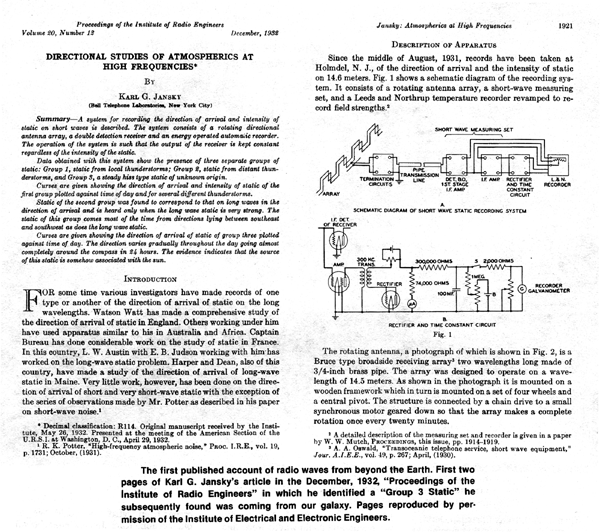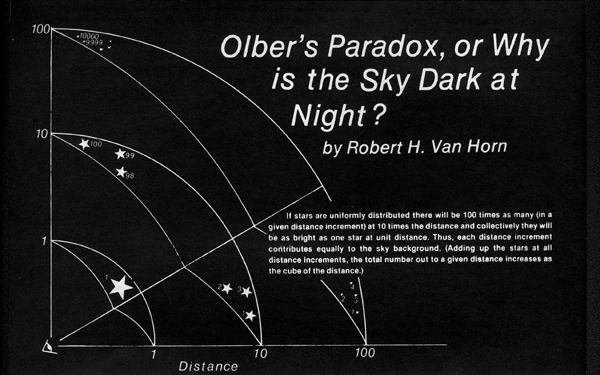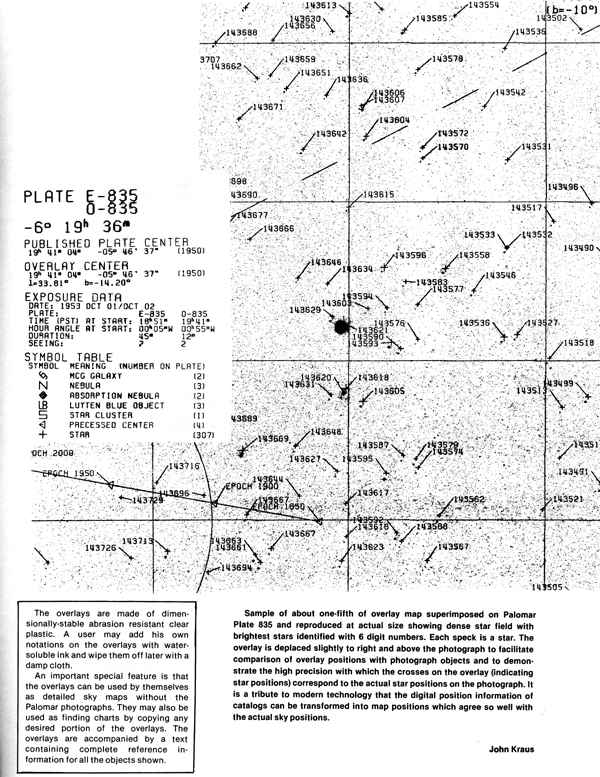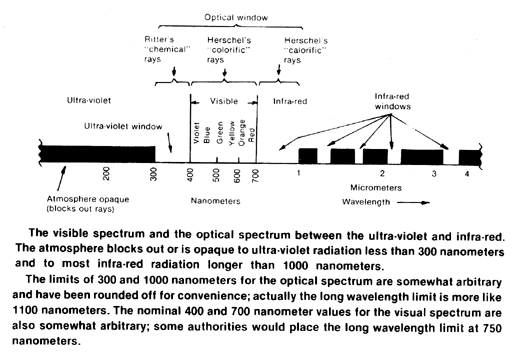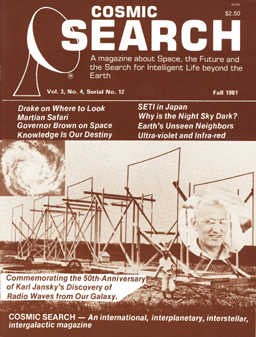![[NAAPO Logo]](../../Images/NAAPOsm.jpg)
North American AstroPhysical Observatory (NAAPO)
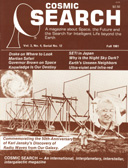
Cosmic Search: Issue 12
(Volume 3 Number 4; Fall (Oct., Nov., Dec.) 1981)
[All Articles & Miscellaneous Items]
|
Webpage Table of Contents (Bookmarks)
(Internal links to items in this webpage)
[Note. Use Back button (or <Alt>+<Left Arrow>) to get back to this Table of Contents after you have clicked on a link and viewed the article.]
Codes Used Below:
P: Starting page of article in magazine; A: Author(s); T: Title of article
|
Martian Safari
By: Dorothy D. Wills

Revealing insights into human foibles and the future
The Unthinking Tinkerer
Let us suppose that our species continues for the next thirty years or so without destroying most of our number, and that what passes for civilization among us survives without either a radical socio-political revision or a total fragmentation into hundreds of introspective geopolitical pieces. Let us suppose that we can solve or at least stave off the solution of our physical problems concerning energy, nutrition, resources, room, without altering the fundamental structure and substance of our global society or our basic nature. Many people think it more likely that by the end of thirty or fewer years we will be living one of the two extreme alternatives: a world utopia in which we have resolved our differences and are at peace with nature, or a world of scattered anarchic groups foraging among the radioactive rubble. We are supposing here that it is equally possible for us to muddle through well into the next century in more or less the same fashion we've gotten through most of this one. This possibility must be considered for at least two complex inter-related reasons, both having to do with fundamental characteristics of human beings.
Firstly, people are extremely poor planners. They not only are unable to foresee the consequences of present or past events even in the very modestly distant tomorrow, but they cannot prevent or prepare for those undesired consequences they can predict. On the large scale, five-year plans are considered long-range by most governments. Twenty years is in the impossibly distant future. On the individual level, people sometimes make life game-plans, often revolving around culturally-defined successes of one kind or another and material prosperity. We know that many such personal life plots
are doomed, that things don't go the way we want them to, not only because the individual fails to take some crucial step, but because people are not good at thinking in whole lifetimes of contingencies, inter-relations, shifting contexts, and all the imponderables of self, others and time.
Most people, of course, simply accept the basic set of life cycle expectations and prerequisites appropriate to their sex and station, that is bequeathed them by their society. Most spend great amounts of time and energy attempting to protect this scenario from any change, however irrelevant or even contradictory its contents seem to their actual experience in the world. Take away the life scenario, and people are forced consciously to comprehend their activities, to plan ahead, and this is the last thing they want to do.
In short, people do not know what they are doing most of the time, as individuals or as societies or nations. It is not being suggested that we are unique among animals in this respect. However, the plans of other creatures are made by nature, not by culture, and so comprehend lifetimes with ease. Also, nature moves more slowly than culture. How can human incompetency in projection and prediction make us suppose that we can avoid killing each other off one way or another?
One of the major concomitants of human future blindness is fear of deviation from the known, though this too has its own unforseen but not unforeseeable consequences, some even more dangerous than those resulting from changes. People do not want to stop doing what they have been doing, do it in another manner, or do something different. Of course, utopias are much less likely than disasters in the presence of no planning. There is little evidence that any prognosticators of imminent bliss have a firm idea of what this bliss might be like or how to attain it. Temporal shortsightedness means that, even in a world where change is the order of the day, individuals and groups will pretend that things remain the same so that they can continue to use their ancient methods of dealing with them. The last thing people will permit to change is themselves. It is often said, "we can't go on like this." This may well be so (certainly we can't go on indefinitely), but amazingly most of us want to.
Secondly, a reason for believing it possible that humanity can go on for a few more decades in its characteristic chaotic style seems paradoxically contrary to the first. Part of the basic biological equipment that has made us a dominant and numerous species is a tremendous adaptability. This is due to the highly generalized nature of our morphology and physiology, the limitations rather than laws set by our heredity, and the capabilities of one of our few specialized organs, the brain (which nonetheless provides most of us, again, with a generalized, not specialized, kind of intelligence). One of the products of this biological endownment is culture, that specialization that makes us the most flexible of all animals, and the most diverse. One of the limitations of that endownment appears to be that people will accept the intolerable, without thinking about it first. Thus, they are myopic about time, inter-connections, implications. And so this myopia makes us fear the future and face away from the basic problems of social structure and personal relationships. Our circumstances and accoutrements may have changed, but we have not.
Human flexibility and culture allow us to live anywhere, eat anything, survive almost any catastrophe, adjust to any situation. Does this not contradict our demonstrated unwillingness to change? Flexibility, like change, is of no intrinsic value; it is neither valuable nor valueless in itself. If an act of creativity is not instilled with values and understood by the actor, it will work counter to his values more often than not. Most actors of course have never examined their values in the first place so as to decide what is of value there. Therefore the values themselves often never change. So people can be flexible in the same way and for the same reasons for an indefinite period without really learning or doing anything new. In other words, adaptation is not the same thing as change.
It seems people will adapt to almost anything rather than try to change it or themselves. They will live in population densities higher than those that drive the lemmings into the sea. They will accept social and environmental conditions so oppressive and deadly that their own children may be prevented from growing up. Modern man will embrace what would cause a less flexible but more reasonable creature to die rather than endure.
So we are a species capable of tolerating what almost any other being would find insane, from air pollution to unjust socio-political systems. Why, then, do we so fear change, the unknown? Why do we find it so hard to figure the future meanings of our present actions? The answer has to do with the special difference between change and adaptation in the case of humans. Adaptation orients the individual to the self and its immediate interests. Change may threaten that self, or its preservation as defined. It may even threaten the definition.
The means by which people adjust to unpalatable and/or new situations ordinarily involve one of two alternatives: a manipulation of the psyche that usually manifests itself as philosophical resignation, or a manipulation of environment and instrumentalities. These are expecially characteristic of European cultures, that are also the main architects of our present-day troubles, and that also occasionally define other human beings as instrumentalities. Neither changes the actor himself, or, consequently, the social structure of the situation, which is what is problematic. Neither requires effort or abstract thought, the major difficulties encountered in planning and predicting. We have a thousand times the intelligence of a cat or a monkey, but we are just as mindless. Thus, people can adapt, and have done so repeatedly over the past fifty thousand years or so, without changing fundamentally and more or less without thinking. We are still self-seeking. We have domesticated and transformed the whole natural world through our intelligence. But we ourselves are still untamed and we tinker but don't think.
Arriving then at the nineteen-eighties, it may safely be supposed that one possible response of living humans to their psychotic world is to put up with it, still tampering with it thoughtlessly as it falls to bits in our hands. Such a response changes nothing, plans nothing. But it might get us through a few more decades.
SAFARI
Let us further suppose that this mindless manipulator who is man perfects, as he well might, the means of leaving his home planet for various regions of the solar system and galaxy Clearly, this is a goal and a capability of at least two nations, and one dear to the peoples of many others as well. The first question to be asked is, why does he want to go out there? Then, what will be the circumstances of his going? What will he do when he gets there?
We are not, of course, talking about a trip everyone will make. Few of us now living will ever leave earth. Early space-farers will include military, para-military engineers and technicians, and occasional scientists. Later, other people will go too, if they can pay, or if society defines them as important and gives them power. In any case, the crew will not be large, and the contingent of humanity found off earth hardly a representative sample.
Speculative fiction and avowed programs of existing space agencies and their associates suggest four main forms space travel will take:
(1) exploration of cosmic bodies and the space around and between them, using robot vehicles;
(2) establishment and occupation of self-contained artifactual bodies, such as orbital space stations;
(3) terraforming1 and colonization of (parts of) other planets; (1. The word means what it says, but can refer to a variety of processes from inducing planet-wide chemical and climatic changes to the construction of hermetically-sealed earth-like environments. The latter is the most familiar alternative to readers of science fiction and astro-engineering manuals. See "The Cosmic Connection" by Carl Sagan,1976, page 170.)
(4) transport of colonies through interstellar space in celestial vehicle-dwellings, requiring immense periods of time, with the goal of carrying out (3) in some other solar system.
The first three programs will eventually require a fifth, namely the creation of a standing force of vehicles that do not do (1) but assist in (2) and (3), supervise and provision their inhabitants, transport their produce, mediate between them and earth.
Before we can hope to understand the meanings, uses, and repercussions of each of these forms of penetrating and exploiting the cosmos, we might ask what such activities have in common with earth-bound pursuits and present or prior history2. (2. The five fronts, as it were, of the war on space's freedom from men are discussed in more detail in "Space Myth 1: Spring Park, USA, Space," by D. D. Wills.) The analogy that comes immediately to mind is with the European age of "discovery" and subsequent colonial epoch. Perhaps space-faring is really a continuation of this period, not a repetition or reincarnation of it. Many of the same elements are present. An intial period of ostensible exploration, mapping, etc., is followed by the implementation of exploitative procedures of various sorts. Where there are natives in the newly 'discovered' regions, economic and political relations must be established, outstandingly trade and military peace. Sometimes these involve immediate imposition of rule, sometimes rule is delayed. Continuing relations require that certain agents of the "explorer" power establish at least temporary residence. These agents are inevitably followed by colonizers, emigrants who go to occupy the "new" territory as its conquerors rather than as potential subjects or citizens of any sociopolitical organization which may already exist there. Again, the presence or absence of natives is critical in characterizing the colonization process. So far as our analogy with space-faring and -colonizing is concerned, this point presents the greatest difficulty. There are no creatures known at present absolutely to be native to any other planets but earth, let alone to the void itself. However, it must be pointed out that once there are inhabitants of formerly-unoccupied places, they themselves become its natives. Thus, other human beings and their decendants [sic; "decendants" should be "descendants"] may be at some future time the natives of other planets, the mythical and much-sought intelligent extraterrestrial beings, in relation to the inhabitants of that time's earth. So if there are no true extraterrestrials, their absence need not delay the playing out of the colonial game for long.
Colonization on earth was and is accompanied by the "Euroforming" of the "new" place, its more or less gradual transformation so that the immigrants could tolerate living there. If there were natives, this included them. Of course the colonists got something from the natives too (sometimes they got killed). They were marked by their new places to varying degrees, up to the point of rejecting their home colonizing world after importing its basic mechanics to the new one. The transformation of the colonized areas and protection and surveillance of their occupants demanded a vertiable [sic; "vertiable" should be "veritable"] army of emissaries, physical and social engineers, governors, and other operators in addition to the actual immigrants, though occasionally the latter could also fill these roles, as could, rarely, natives. Among the more familiar of those taking part in Euroforming, however unwittingly, were missionaries and other kinds of proselyters, anthropologists3 and scientific researchers, merchants, political and military functionaries. (3. Anthropologists do this by describing and interpreting other cultures in terms Europeans can grasp, which has the unfortunate side effect (frequently unintentional) of Euroforming those cultures not only in the minds of Europeans and social scientists, but ultimately natives as well.
Anthropologists are, of course, guilty of other colonialistic activities, too.)
One of the most interesting later characters in this developmental scenario of "explore-exploit-inhabit-transform" is the visitor, who comes in any number of guises from tourist to artist to the white hunter. Visitors come to places which retain something of their original or natural character even after extensive Euroforming. Since it is difficult completely to transform any place, expecially if there are natives, and it is important to preserve some basis for the self-other or we-they opposition, many places will be eligible for visitation. The white hunter represents all that is pernicious about European culture. He executes all the maneuvers of the colonial sequence on a smaller scale all on his own. He embodies the entire cultural mentality associated with it and plays all the roles himself in every scene.
White Hunter chooses a place which he has defined as exotic and full of adventure. This could be the Mars of 2020 as easily as the India or the Africa of 1930. He and his entourage of other white hunters and their clients and acolytes go there to get some of this adventure in a safe way and hopefully bring a bit or a sign of it back home so home will be a little less the dull routine he was trying to get away from in the first place. But he brings a lot of home with him when he goes, too, not just the contents of his mind. With these tools he Euroforms as much as possible of his immediate environment, yet all the while maintaining his philosophical distance from the "exotic" surroundings beyond it. The cultural opposition must be maintained or White Hunter will fail to get what he came for: a transient and carefully-orchestrated but thrilling contact with that which is seen to be utterly unhomelike; it may be inferior and undesirable as a permanent setting, but it satisfies White Hunter's need to tinker mindlessly and confirms his definition of himself as superior to anything, even the fear of the strange.
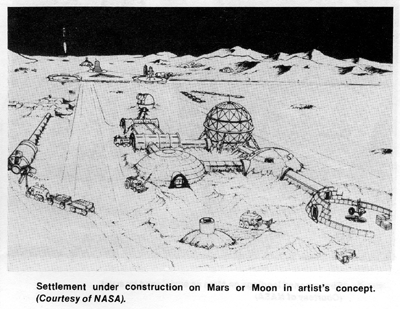 A Martian safari will not be much like a hunt for big game trophies at the foot of Kilimanjaro. But it is certain that there will be its structural and even contentive equivalents, including the imported whiskey, bored wife who seduces the guide, and 'native' bearers (real "aliens" or Martian humans). Exactly what White Hunter will do on a Martian safari and what prizes he will bring home will no doubt remain a mystery for many years to come. The recent Viking reports, even with their tantalizing biochemical enigmas, do not immediately suggest the nature of the exotic expreiences visitors of the future will be able to seek there. Perhaps merely going there and bringing back some bit of landscape not yet defined as life or not-life will be enough for White Hunter of the year 2020.
A Martian safari will not be much like a hunt for big game trophies at the foot of Kilimanjaro. But it is certain that there will be its structural and even contentive equivalents, including the imported whiskey, bored wife who seduces the guide, and 'native' bearers (real "aliens" or Martian humans). Exactly what White Hunter will do on a Martian safari and what prizes he will bring home will no doubt remain a mystery for many years to come. The recent Viking reports, even with their tantalizing biochemical enigmas, do not immediately suggest the nature of the exotic expreiences visitors of the future will be able to seek there. Perhaps merely going there and bringing back some bit of landscape not yet defined as life or not-life will be enough for White Hunter of the year 2020.
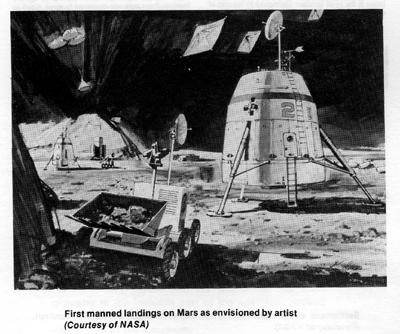 This little colonial scene transposed in time may not seem particularly threatening or even interesting, its interest and harm lie in the thought processes of the participants (expicially [sic; should "expicially" be "especially"?] White Hunter and his like), and in the social relationships among them. White Hunter has relationships of a certain kind with his wife and other companions from home (which we shall not go into here), with the guide and with the natives. He does not have personal, human relationships with any of the latter, though he may behave very familiarly, even intimately, with them. This refusal to establish personal relations with 'the natives' is another colonialistic attribute of some anthropologists, as discussed by Hsu4. (4. There may be other reasons for it, too, apart from a colonial feeling of superiority and desire to maintain distance. It may have to do with the problematical nature of the philosophical notion of 'subject' for pragmatic human conduct. It may also be related to the fact that most individuals suffer when they lose contact with cherished others, and one way of avoiding such suffering is not to cherish when one knows beforehand that one's situation is temporary and that loss will consequently surely come. This is complicated by the peculiar modern truth that some people seek superficiality and transiency even in those relationships they might well expect to endure till death. See "Role, affect and anthropology," by Francis L. K. Hsu in, American Anthropologist, 1977, Vol. 9, Page 4:805.)
This little colonial scene transposed in time may not seem particularly threatening or even interesting, its interest and harm lie in the thought processes of the participants (expicially [sic; should "expicially" be "especially"?] White Hunter and his like), and in the social relationships among them. White Hunter has relationships of a certain kind with his wife and other companions from home (which we shall not go into here), with the guide and with the natives. He does not have personal, human relationships with any of the latter, though he may behave very familiarly, even intimately, with them. This refusal to establish personal relations with 'the natives' is another colonialistic attribute of some anthropologists, as discussed by Hsu4. (4. There may be other reasons for it, too, apart from a colonial feeling of superiority and desire to maintain distance. It may have to do with the problematical nature of the philosophical notion of 'subject' for pragmatic human conduct. It may also be related to the fact that most individuals suffer when they lose contact with cherished others, and one way of avoiding such suffering is not to cherish when one knows beforehand that one's situation is temporary and that loss will consequently surely come. This is complicated by the peculiar modern truth that some people seek superficiality and transiency even in those relationships they might well expect to endure till death. See "Role, affect and anthropology," by Francis L. K. Hsu in, American Anthropologist, 1977, Vol. 9, Page 4:805.)
The point is that the real problems and dangers of the exploration and exploitation of the heavens may be the same ones we have on earth now, not failures of engineering and technology but of humanity, social justice, and personal communication. These are much more subtile [sic; should "subtile" be "subtle"?] than some of the more commonly-cited dangers of space-faring, such as domination of one people by another from above, war on an unimagineable scale, pollution and destruction of the material environments of an entire solar system, even exportation of false or deadly human ideas, ways and things to the innocents of other worlds. These are all quite possible, even likely, though it would seem superfluous for example to wage heavenly war when we can virtually blow up the globe right now without the bother of leaving it. But naturally if some national power doesn't mind going somewhere else after its victory or waiting for 500,000 years while the earth cools off, it would have an advantage in attacking its enemy from space, as long as the latter is on the ground. Some people might think war would be better fought in space, that it would thereby prevent the permanent pollution of the planet and death of untold civilian population, that it would hence be cleaner and better! And of course some of us dominate others of us just as effectively from next door as from above.
Will we transport our social problems and diseases of character into our various space environments intact? Do we really have the power to contaminate a solar system? Will we not be affected by our space-going experiences? Can our society as presently constituted survive the creation of science sufficient to space-faring and existence in an unearthly setting?

 Dorothy D. Wills is an anthropologist with interest in linguistics, futurology and in how cultures adapt. Born in San Antonio, Texas, in 1947 she received her Bachelor's degree from Mt. Holyoke College (Massachusetts) in 1969 and Master's and Doctor's degrees from the University of Texas at Austin in 1972 and 1979 respectively. Dr. Wills is currently Visiting Assistant Professor in the Middle Eastern Studies Center at the University of Texas at Austin. Later this year she expects to be teaching at the University of North Carolina at Chapel Hill. She has written scholarly articles on learning and communication, culture and conceptualization and space and futuristics, as well as fiction, both science and non-science.
Dorothy D. Wills is an anthropologist with interest in linguistics, futurology and in how cultures adapt. Born in San Antonio, Texas, in 1947 she received her Bachelor's degree from Mt. Holyoke College (Massachusetts) in 1969 and Master's and Doctor's degrees from the University of Texas at Austin in 1972 and 1979 respectively. Dr. Wills is currently Visiting Assistant Professor in the Middle Eastern Studies Center at the University of Texas at Austin. Later this year she expects to be teaching at the University of North Carolina at Chapel Hill. She has written scholarly articles on learning and communication, culture and conceptualization and space and futuristics, as well as fiction, both science and non-science.
|
|
When the Brightest is the Farthest
By: Frank D. Drake
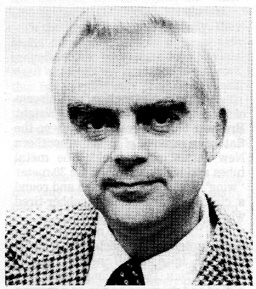 In the search for exterrestrial radio signals, where should we point our radio telescopes? The answer seems easy. Go out on a sparkling clear night and look at the sequin panorama of the sky; the blazing lights of the few first magnitude stars, seemingly silhouetted against the shimmering gossamer of the Milky Way and multitude of faint stars. Surely if we pointed our telescope at the brightest of stars, we would be looking towards the nearest of stars, and our chances of success would be greatest. Wrong!
In the search for exterrestrial radio signals, where should we point our radio telescopes? The answer seems easy. Go out on a sparkling clear night and look at the sequin panorama of the sky; the blazing lights of the few first magnitude stars, seemingly silhouetted against the shimmering gossamer of the Milky Way and multitude of faint stars. Surely if we pointed our telescope at the brightest of stars, we would be looking towards the nearest of stars, and our chances of success would be greatest. Wrong!
The following is not a misprint: If you compare the list of the hundred brightest stars in the sky with the list of the hundred nearest stars, you will find only four stars in common: Sirius, Procyon, Altair, and Alpha Centauri. The nearest star, Proxima Centauri, is more than a hundred times fainter than the faintest star visible to the naked eye. The closest star after the Alpha Centauri system, Barnard's Star, is more than twenty times too faint to see. In fact, the typical magnitude of a star on the "closest star" list is something like the eleventh magnitude, about a hundred times fainter than the faintest star visible to the naked eye. Then just where are the ninety-six other bright stars on the "bright star" list? Far, far away. They still shine brightly because they are instrinsically very bright.
All of this is one of the cosmos' more clever tricks, almost as though nature were trying to invent a puzzle to prove that intuition can lead us astray. What has happened here? The processes of star formation have led to a huge range in the intrinsic brightness of stars, a range of a hundred million. There are far more of the faint stars than the very brightest; in fact, the density of the faintest stars is very roughly a million times higher than the density of the brightest stars. This
relationship between star densities and brightness has been given the lofty name "luminosity function." It so happens that the luminosity function for our galaxy provides very few intrinsically bright stars. But, and this is why the trick works, there are enough of the brightest stars to cause the nearest ones, still so very far away, to outshine the truly nearest and faintest stars.
If an astronomer on Venus, theorizing that there are things like stars in the sky, lofted a small telescope above the canopy of clouds which had until then concealed the true appearance of the night sky from the Venusians, which stars would be first discovered (besides the Sun!)? We now know the answer to this. Not the nearest! They would be the farthest, the intrinsically brightest!
Now the luminosity function of the stars is nothing remarkable, no freak of the cosmos. All galaxies seem to have similar luminosity functions. And, so do the cosmic radio sources. The four brightest radio sources in the sky are not at all among the close sources; two are distant supernova remnants, one is a radio galaxy millions of light years away, and the other is one of the most distant radio galaxies we can photograph. The luminosity functions would have to be very different before the brightest things in the sky would be the closest.
There is a profound message here to those who plan the strategy for SETI. It is entirely reasonable that intelligent civilizations, too, have a luminosity function such that there are far more intrinsically faint civilizations than intrinsically bright ones. Then, as with the stars and cosmic radio sources, the easiest civilizations to detect will not be the closest, but will be the intrinsically brightest and farthest! A little math shows that this will be true even when for every 300 civilizations transmitting at certain radio power, there is but one civilization which transmits signals ten times more powerful. If anything, it is reasonable to expect the SETI luminosity function to produce even more relatively high power transmitting worlds than this. This will cause the brightest, farthest civilizations, to dominate the airwaves even more.
Alas, this says that the intuitively "right" strategy of "point towards the nearest stars," is probably not right at all. Instead, we should point in the directions where we will encompass the greatest number of stars within the radio telescope beam. Point towards the central plane of the Milky Way. Point towards the center of the galaxy in Sagittarius. Perhaps even point towards nearby galaxies. We can even cover all possibilities at once if we point in directions near the central plane of the galaxy where the telescope beam will also include nearby stars. The planners of SETI are aware of all this, and the plans for future major searches take the luminosity function into account.
The next time you are gazing at that glimmering night sky, and wondering where They might be, don't imagine Them to be next-door-neighbors. They, the bright ones, are probably among the myriad faint stars of the Milky Way.
 Dr. Frank D. Drake is Director of the National Astronomy and Ionosphere Center of Cornell University which includes the Arecibo Observatory. Dr. Drake is a member of the Editorial Board of COSMIC SEARCH.
Dr. Frank D. Drake is Director of the National Astronomy and Ionosphere Center of Cornell University which includes the Arecibo Observatory. Dr. Drake is a member of the Editorial Board of COSMIC SEARCH.
|
|
The First 50 Years of Radio Astronomy,
Part 1: Karl Jansky and His Discovery of Radio Waves from Our Galaxy
By: John Kraus
In 1930 essentially all that we knew about the heavens had come from what we could see or photograph. Karl Jansky changed all that.
A universe of radio sounds to which mankind had been deaf since time immemorial now suddently burst forth in full chorus.
A bizarre contraption, reminiscent of the wing frame of an early Wright Brothers biplane, rotated slowly on the flat, open expanse of a fallow, southern New Jersey potato field. The metal tubes and wooden slats of the 30-meter "wing" rolled silently round and round a circular track on four rubber-tired wheels from a Model-T Ford.
The "wing" was a rotating directional antenna. Connected to a radio receiver in a small nearby shack, signals from the antenna were amplified and recorded by pen on a moving paper chart. On a warm autumn afternoon of 1931 a slender young radio engineer was puzzling over the long strip of paper flowing from the recorder.
An airplane "wing" rotating on automobile wheels in a potato field — what an improbable, unlikely combination! Yet it had been constructed for a very definite purpose. Karl Jansky, the young engineer, had built it to investigate the direction of arrival of the crackling thunderstorm noise or "static" which interfered with radio-telephone conversations over trans-Atlantic short-wave links of the Bell system.
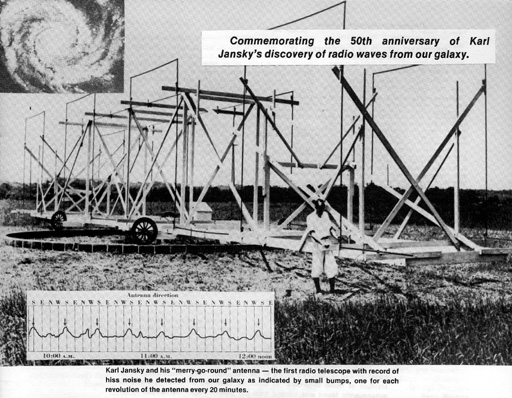
Jansky found what he was looking for. Some static came from local thunderstorms, other static from more distant ones, the strength fluctuating greatly from hour to hour and day to day. But also, so weak that he might have ignored it, was a faint persistent static, always there, whose direction moved almost completely around the horizon once each day. Listening to the static with earphones, Jansky described it as a hissing sound "that can hardly be distinguished from the receiver noise." This hiss-like static Jansky had not expected or anticipated but it excited his curiosity and he determined to track it down.
He ruled out local interference from power lines or electrical equipment; he ruled out terrestrial sources. Could it come from the sun, he wondered. After further observations he concluded that the noise was coming from beyond the earth, beyond the sun and the solar system; it was coming in fact from the center of our galaxy or Milky Way system.
Jansky's airplane "wing" was the first radio telescope and with it he opened a new corridor to the cosmos! A universe of radio sounds to which mankind had been deaf since time immemorial now suddenly burst forth in full chorus. Humans could now turn, not only their eyes but also their radio ears to the heavens!
Jansky's discovery revolutionized astronomy and our ideas of the universe but in the 1930s astronomers and engineers hardly raised an eyebrow. It was a truly historic occasion when Jansky presented his final paper about his discovery on July 3, 1935, at the National Convention of the Institute of Radio Engineers in the Statler Hotel in Detroit, Michigan. However, scarcely two dozen people were in the audience. I was fortunate to be one of them.
Before describing Jansky's discovery and its consequences in more detail, let me provide a bit of historical perspective.
In ancient Greece hundreds of years before Christ, Hipparchus charted the stars. Later, Tycho Brahe of Denmark and Johannes Kepler of Germany studied the planets. Based on their work, Isaac Newton, a Cambridge University professor, enunciated his laws of motion in 1687. Meanwhile Galileo had built the first astronomical telescope and subsequently William Herschel built much larger ones leading to the modern era of observational astronomy. Newton's prism led to spectra of the stars and knowledge about their chemistry. Coming to the 20th century, Harlow Shapley measured the extent of our galaxy while Edwin Hubble noted the apparent recession of other galaxies suggesting that we live in an expanding universe. Much had been learned and, yes, there were questions to be answered but the sky seemed like a stable, well-ordered place where changes took place slowly, if at all. This was our picture of the firmament 50 years ago when Karl Jansky's merry-go-round telescope started turning.
Let us follow another path from the past to Jansky's telescope. Six centuries before Christ the ancient Greek astronomer-philosopher Thales knew that amber rubbed with a cloth became electrically charged. This phenomenon gives us our word "electricity" from the Greek word "elektron" for amber. Ancient sailors are reported to have used loadstone or magnetic compasses for navigation so electric and magnetic effects were known long ago. But electricity and magnetism were regarded as separate, unrelated phenomena and light as something still different.
Then in 1819, Hans Christian Oersted of Denmark discovered that a compass needle could be deflected by a wire carrying an electric current; electricity produced magnetism. A few years later, Michael Faraday in London demonstrated that a change in magnetism, produced by plunging a bar magnet into a coil of wire, induced an electric current; magnetism produced electricity.
The foundations had been laid and in 1873, Cambridge University professor, James Clerk Maxwell, propounded his laws relating electricity and magnetism. He postulated that light was an electromagnetic wave and further that electromagnetic waves of other lengths should be possible. Soon Heinrich Hertz, a professor at Karlsruhe, Germany, produced and measured electromagnetic waves a million times longer than light. These radiations, we now call radio waves, were put to practical use by Guglielmo Marconi, particularly for ship-to-shore telegraphy. By 1920 radio broadcasting had begun and radio waves were finding many other important applications. One of these was trans-oceanic telephone service using the then relatively short wavelengths of a few tens of meters. This was the setting in 1930 when Karl Jansky began his experiment that was destined to revolutionize our knowledge of the universe. From light waves confined to a "window" about one octave wide, Jansky opened a broader radio "window" dozens of octaves wide. Soon this radio window would reveal a violent, dynamic universe barely hinted at by earlier visual observations.
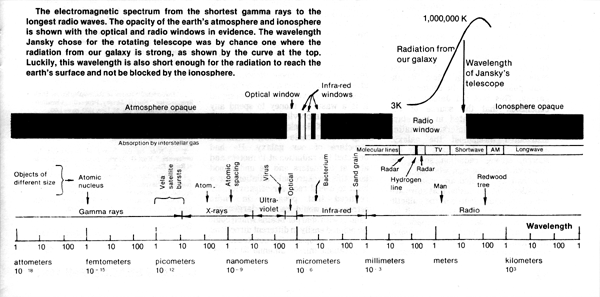
I have sketched briefly the history of optical astronomy and the events leading to the status of radio in 1930 when the sky belonged entirely to the realm of optical astronomy. Essentially all that we knew about the heavens had come from what we could see or photograph. Karl Jansky changed all that.


Karl Guthe Jansky was born in 1905 in what was then the Territory of Oklahoma where his father was Dean of the College of Engineering at the University of Oklahoma. Dean Jansky had been born in Wisconsin of Czech immigrant parents who came to the U.S. in 1867. Karl's mother, nee Nellie Moreau, was of French-English descent. In 1908 the family moved to Madison where father Jansky became a member of the Electrical Engineering faculty at the University of Wisconsin. Karl attended the university, obtaining a Bachelor of Science in physics in 1927. Because of his high scholarship, he was elected a member of Phi Beta Kappa. He also excelled athletically as the fastest man on the university's ice-hockey team.
In 1928, Karl Jansky joined the staff of the Bell Telephone Laboratories, assigned to the study of static and other radio interference. Some of his work was done at the long wavelength of 4000 meters. In March 1929, while still working on the long wavelength static, he began to design a system for observing static at about 15 meters, a wavelength coming into use for trans-Atlantic telephone service. His design included a rotating directional antenna, receiver and recording arrangement. Construction of the antenna began in the fall of 1929 and a year later the antenna and associated receiver-recorder were installed at an observing site near Holmdel, New Jersey. In the late summer of 1931 Karl Jansky started his antenna turning and his recorder running on a continuous basis and by that winter the mysterious hiss-like static was definitely recognized.
For some weeks the hiss-like static seemed to be strongest when the directional antenna was pointed toward the sun. However, over a period of some months the maximum moved away from the sun, following a fixed point among the stars which Jansky placed close to the center of our galaxy.
Our galaxy is an aggregation of some 100 billion stars turning slowly like a great wheel in space. Although the center of our galaxy is obscured from optical observation by intervening gas and dust it is a strong source of radio-wave emission.
In retrospect it in interesting to note that the system Karl Jansky designed for studying 15-meter wavelength static had:
(1) A directional antenna (which to my knowledge was the largest rotatable antenna in existence at the time).
(2) A receiver that was as quiet as the state of the art permitted, the noise level being limited by the electron noise of the vacuum tubes.
(3) A receiver responsive to a relatively wide band of wavelengths, much wider than in conventional receivers of the period.
(4) An averaging arrangement, called a long time-constant circuit, to smooth out the pen trace on the recorder chart.
All of these four characteristics are essential to modern radio telescopes. I believe that Jansky was the first person to combine these all together and in so doing he built the first successful radio telescope!
Others before Jansky had tried without success. In 1895 Oliver Lodge wondered if Heinrich Hertz's newly discovered waves might not be emitted by the sun. He set up a simple receiving system in Liverpool, England, but detected nothing except static and disturbances he attributed to passing street cars and nearby electrical equipment. Lodge concluded correctly that if such waves did exist his equipment was not sensitive enough to detect them. He further recommended that subsequent experiments be conducted "in some isolated country place" to avoid man-made interference. Lodge was a man ahead of his time.
Thomas Alva Edison also tried unsuccessfully to receive radio waves from the sun, while Nikola Tesla set up transmitting and receiving equipment near Pikes Peak, Colorado, in an unsuccessful attempt to "talk to the planets." All of these experiments were at long radio wavelengths. In contrast, Arthur Adel and I tried to detect radio waves from the sun in 1933 at short centimeter wavelengths with ammonia-line microwave equipment at the University of Michigan. Adel, now an astronomer at Northern Arizona University, theorized correctly that such radiation might be associated with activity near sun spots on the solar disc. However, our equipment, like Lodge's, was much too insensitive and we obtained no indication of the radiation.
By 1935 Jansky had demonstrated that the hiss-like radiations were received any time his antenna was directed towards some part of our galaxy, revealing its structure in a rudimentary way. The greatest response was obtained when the antenna pointed toward the center of our galaxy. This fact led Jansky to the conclusion that the source of the radiations was located in the stars themselves or in the interstellar matter distributed throughout the galaxy. Jansky noted that, if stars were the source, strong radiation should be observed from the sun, whereas at no time had he detected any solar radio radiation. His conclusion that stars are not an important source of the galactic radiation is correct. However, it so happened that Jansky had made his observations during a sunspot minimum. Had he continued his observations a few years more, he would undoubtedly have detected solar radiation during a period of high sunspot activity. Unfortunately, Jansky was soon transferred to other research activities, and years were to pass before further advances were made in the still unrecognized new science of radio astronomy.
Jansky suggested that the hiss-like static "might be caused by the thermal agitation of charged particles which are found in the very considerable amount of interstellar matter that is distributed throughout the Milky Way." Jansky's suggestion turns out to be correct if the words "thermal agitation" are interpreted to include electrons moving at high velocity in a magnetic field.
Jansky was well aware not only of the astronomical importance of his discovery but also of its practical implications. For example, he wrote in 1935 that "this star static, as I have always contended, puts a definite limit upon the signal strength that can be received from a given direction at a given time and when a receiver is good enough to receive that minimum signal it is a waste of money to spend any more on improving the receiver." Thus, by 1935 Jansky had identified the origin of the radio radiation with the structure of our galaxy. He had detected the radiation at 15 meters and also at 10 meters and he understood how this background radiation set a limit to useful receiver sensitivity. He realized that progress in radio astronomy would require larger antennas with sharper beams which could be pointed easily in different directions. In fact, he proposed the construction of a parabolic-mirror antenna 30 meters in diameter for use at meter wavelengths. However, he obtained no support for his proposal, and radio astronomy languished.
Karl Jansky died in 1950 at the age of 44. He had contracted Bright's disease, or nephritis at an early age resulting in a chronic kidney condition from which he never fully recovered. Although Grote Reber and a few others made advances in radio astronomy prior to 1950 there was yet nothing at the time to hint of the great leaps that would soon follow. Regrettably Karl Jansky did not live to witness the tremendous astronomical revolution that resulted from his discovery. However, his name
is commemorated in the radio astronomy unit, the jansky, for flux density or strength of radiation, putting him in the illustrious company of other electrical pioneers for whom the watt, ampere, volt, ohm, coulomb, hertz and farad are named.
References
1. "Directional Studies of Atmospherics at High Frequencies," Karl G. Jansky, Proceedings Institute of Radio Engineers, vol. 20, Dec. 1932, page 1920.
2. "Electric Disturbances Apparently of Extraterrestrial Origin", Karl G. Jansky, Proceedings
Institute of Radio Engineers, vol. 21, Oct. 1933, page 1387.
3. "A Note on the Source of Interstellar Interference," Karl G. Jansky, Proceedings Institute
of Radio Engineers, vol. 23, Oct. 1935, page 1158.
4. "My Brother Karl Jansky and His Discovery of Radio Waves from Beyond the Earth", C. M. Jansky,
Jr., Cosmic Search, vol. 1, Fall 1979, page 12.
5. "Radio Astronomy," John Kraus, McGraw-Hill Book Co., New York, 1966, pages 6 and 328.
6. "Big Ear," John Kraus, Cygnus-Quasar Books, Powell, Ohio 1976, page 21.
7. "The Changing Universe," John Pfeiffer, Random House, New York, 1956.
|
An Interview with Karl Jansky
On a Special NBC Program on "Radio Sounds from Among the Stars"
At 8:30 P.M. Eastern Time on Monday, May 15, 1933, the National Broadcasting Company Blue Network announcer began "Good evening Ladies and Gentlemen, tonight we will let you hear radio impulses picked up from somewhere outside the solar system, from somewhere among the stars, a pick-up that will break all records for long distance. These hiss-like impulses were discovered by Karl G. Jansky of the Bell Telephone Laboratories. In a moment I want you to hear for yourself this radio hiss from the depths of the universe coming from Mr. Jansky's sensitive receiver at Holmdel, New Jersey."
After 10 seconds of hiss which some listeners said sounded like steam escaping from a radiator, the announcer continued, "Mr. Jansky is here in the studio tonight and I am going to ask him to tell us from what part of the sky the radio hiss is coming."
"The observations," Jansky responded, "show that the maximum of hiss comes from...a point in the Milky Way in the constellation Sagattarius...from the center of our galaxy. "The announcer then asked, "Have these radio waves a definite wavelength?" "No," Jansky said, "they seem to be of all wavelengths. It happens that my observations were made on a wavelength of 14.6 meters but I feel sure these impulses will be found all up and down the radio spectrum."
After some further dialogue with Jansky and 10 seconds more of hiss, the announcer then commented on the immense power that was needed at the center of our galaxy, 30,000 light-years distant, to reach the Earth. "It would have to be," he said, "millions of millions of millions of times more powerful than any radio station we have on Earth today.
The announcer concluded with a suggestion that listeners keep their antennas in first-class condition to get the full benefit of the wonderful programs on the air.
The evening NBC Blue Network had a national coverage equal to or exceeding the most popular radio or TV shows today and millions of Americans became aware for the first time of radio waves from beyond the earth. Some listeners wrote that it was dangerous to probe too deeply into the nature of things since it could upset the delicate balance of the cosmos. Others wrote that Jansky had missed the real significance of his findings, namely that intelligent beings somewhere in the galaxy were trying to communicate with us.
Note: Jansky's prediction that the radio hiss from our galaxy "will be found all up and down the radio spectrum" was correct. In fact, two years later he detected it at a wavelength of 10 meters and he wrote that he planned to "make a study of it in the range from 3.5 meters to 10 meters." Apparently he was unable to carry out this study but was assigned instead to the more practical problem of studying ignition noise from motor boats. However, his advice was frequently sought concerning the ultimate sensitivity of receiving systems and he pointed out (December 1936) that at the meter wavelengths in question "the weakest signal that can be picked up is not determined by the receiver but by the intensity of the 'star noise' which sets a lower limit to the signal strengths that are useable from a given direction at a given time and at a given wavelength."
|
|
The jansky
The unit used by radio astronomers for the strength (or flux density) of radio sources is the jansky (symbolic form; Jy.). The jansky is equal to one-hundreth of one trillionth of a trillionth of a watt per square meter per hertz. In scientific symobolic notation this is expressed
1 Jy = 10-26 W m-2 Hz-1
Note that in accordance with the SI (System International) notation, the unit jansky is not capitalized when written out but it is capitalized in its symbol form (Jy). This convention is followed whenever a unit is named after a person. Thus, we have the watt (symbol W), the hertz symbol (Hz), both named after persons, but the meter (symbol m) because the meter is not named after a person. Typical strong radio sources have strengths of 10 to 100 janskys (10 Jy to 100 Jy) while weaker ones are measured in thousandths of a jansky or millijanskys (symbol mJy).
|
|
THE FIRST 50 YEARS OF RADIO ASTRONOMY
by John Kraus
Part 1. "Karl Jansky and His Discovery of Radio Waves from Our Galaxy." This issue of COSMIC SEARCH (No. 12).
Part 2. "Grote Reber and the First Radio Maps of the Sky." COSMIC SEARCH. (No. 13).
Part 3. "Post-War Radio Astronomy." An emerging science with more radio astronomers than radio sources. The hydrogen line and the first maps of the galaxy. Cygnus A. Cassiopeia A. COSMIC SEARCH (No. 14).
Part. 4. "Radio Astronomy in the 1960's." Quasars, pulsars, Big Bang Background, Molecules in space, the Cambridge survey. COSMIC SEARCH. (No. 15).
Part 5. "Radio Astronomy in the 1970s, 80s and Beyond." COSMIC SEARCH (No. 16).
|
|
Note. Due to the cancellation of publication of COSMIC SEARCH following Issue 13, Parts 3, 4 and 5 of THE FIRST 50 YEARS OF RADIO ASTRONOMY were not published.
Jerry Ehman, Webpage Editor
|
|
|
Knowledge is Our Destiny
By: Robert H. Van Horn
"Knowledge is our destiny." So said the late Jacob Bronowski, mathematician, biologist, author and producer of the TV series, "The Ascent of Man." "Knowledge is our destiny" was a succinct summing up of his account of the growth of our knowledge of our world and the universe around us from prehistoric times to the present. It was a growth of knowledge based first on observation and then organization of these observations through thought and insight into common patterns we call theories. That body of knowledge derived from observable fact and organized by rational thought, we call science. Growth of that knowledge is indeed our destiny, for man has an ever present inner drive to know the world around him,how it works, and how to use that knowledge for his own ends.
Bronowski was not the first or only writer to associate knowledge with destiny. The ancient writers of the Book of Genesis tell how in the Garden of Eden, Eve was tempted to taste the fruit of the Tree of Knowledge of Good and Evil. Giving in to that temptation, she tasted the fruit, and in so doing she became, perhaps, mankind's first scientist. Adam joined her in the experiment, — and when it got them into trouble, he blamed the whole thing on her. This experiment, this first pursuit of knowledge changed forever the course of human history. Gaining knowledge does something irreversible for mankind. There is no going back; the gates to the Garden are forever closed.
So it has been throughout human history. In our time, we have tasted the fruit of the tree of knowledge of the atomic nucleus. It is knowledge of good and evil for it has brought us both nuclear medicine and nuclear war. And there is no return to our pre-nuclear Eden. In pre-history, man learned the principle of the wheel, bringing a marvelous easing of daily tasks on the one hand, and traffic jams and engines of war on the other. And who would go back to a pre-wheel world? Where would we be without wheels? Or paring knives and swords? Or gasoline engines and pollution?
Will our exploration of space be similar? Certainly our view of ourselves and our world from space has had an irreversible impact on us. We cannot go back to a pre-Apollo or pre-Soyuz world. Our new visions, our new technologies will bring us great benefits. But will there be another side? The military use of space may be devastating. Will there be a space litter problem? Or problems as yet unforseen?
Like all advances in knowledge, whether it turns out to be good or evil is up to us. If we approach the future in space with a reverence for the universe and all that Nature has created within it, we can have a glorious future. If we approach that future thoughtlessly with concern only for immediate gain or power, we can destroy ourselves. The choice is ours. It will take all the wisdom that we can muster to handle the new knowledge that will be ours for the taking.
Robert H. Van Horn
|
|
In Review:
By: Robert H. Van Horn
The First Stargazers: An introduction to the Origins of Astronomy
by James Cornell
262 pages, Charles Scribner's Sons, New York, 1981, hard cover, $15.95
Stonehenge, the Pyramids of Egypt and Central America — what images they conjure up of ancient priests and princes performing secret rites to guide and protect the destinies of the peoples. James Cornell in his new book, "The First Stargazers," gives us a comprehensive account of how the new science of archaeoastronomy is deciphering the old mysteries of Stonehenge, the Pyramids, and a host of other structures, artifacts, and relics by which pre-literate man related the movements of the sun, moon, and stars to his daily life. If you wonder about how man got started on astronomy and
the other sciences, "The First Stargazers" is for you.
Stonehenge, as many already know, was a primitive observatory. Its priests could predict the exact arrival of equinoxes and solstices. They could also predict eclipses by various sightings along lines joining selected stones. This provided early Britons with a precise calendar for planting, harvesting, or religious festivals. Similarly, the ancient Egyptians used pre-dawn sightings of the rise of the bright star, Sirius, to signal the summer solstice and the annual rise of the Nile. Cornell gives us a detailed history of how archaeologists and astronomers joined forces (not without much struggle) to arrive at a rational and coherent view of early man's astronomy.
Britons, Egyptians, and Central American Mayans were not the only pre-literate people to live by the sun, moon and stars. Cornell tells us how the people of Africa, Asia, Micronesia, and the Indians of North America have left us striking evidence of astronomical sophistication. For example, remnants from an Indian village at Cahokia, Illionois, are arranged in a circle and so oriented to the path of the sun that the site has been dubbed, "Woodhenge." "The First Stargazers" is rich with such examples.
In his Introduction, Cornell comments, "We still don't know if the observations of the stars, sun, and moon cycles led to an awareness of other natural phenomena, such as seasonal changes, animal migrations, and the growing habits of edible plants; or if just the reverse was true, and the observation of these natural and vital cycles led to a desire to predict them more accurately with a sky calendar. The intellectual development may not be as important as the simple awakening to the cyclic nature of life and the need for counting, measuring, and time-dating skills." But in astronomical awareness, there was a beginning.
In his final chapter, Cornell notes, "As we stand beneath a star-dappled sky and stare into space, we are linked in mind and spirit to those other watchers of the skies, who, in millenia long ago, gazed upon these same stars and perhaps asked the same questions."
What a pity it is that we are shutting ourselves off from those stars with city lights, smog, and perhaps worst of all, indifference. Can mankind retain the humanity it shares with these ancient ancestors if it blots out its view of those stars which led to its first steps upward?
Cornell has done us a favor by giving us this view of "The First Stargazers." For those who wish to dig deeper, there is an extensive bibliography.
The Quest for Extraterrestrial Life, A Book of Readings,
by Donald Goldsmith;
Foreword by Sir Fred Hoyle;
308 pages, University Science Books, 1980; hard cover.
In "The Quest for Extraterrestriai Life," Donald Goldsmith gives us the texts of fifty eight original papers on the subject beginning with Lucretius,"On the Nature of Things," dated about 70 B.C. to the recent writings of Carl Sagan, Philip Morrison, Ronald Bracewell, Gerard O'Neill, and many others.
This is an excellent source book, fascinating for browsing, and useful for reference. It belongs on the shelf of any SETI devotee.
|
|
The Extrasolar Planetary Foundation Report
By: George Gatewood
During the spring quarter the Extrasolar Planetary Foundation became an active and meaningful entity. A number of people decided to support our effort and become charter patrons, and our first special campaign has, thanks to Dr. Bernard Oliver of the Hewlett-Packard Corporation, become a significant effort.
Dr. Oliver has agreed to match all gifts to our drive for the instrumentation fund up to a total of $20,000. The first object of this campaign, as described in our last report (COSMIC SEARCH Spring 1981), is to obtain a new very high precision lens for the Allegheny Observatory 30-inch refractor. Combined with its new electronic detector, this telescope will be humanity's first operational system capable of detecting other planetary systems.
The Foundation also received two H-8 computers from Drs. Gilbert and Jaylee Mead of Goddard Space Flight Center. The first of these will be used for pointing control in the above system, and the second will be used by the Foundation to keep its records and maintain a mailing list. Others joining our charter patrons were: David Robinson, Leo J. Scanlon, Peter Koch and several anonymous donors.
In view of Dr. Oliver's offer, this is an especially good time to join the above list. We have a very real opportunity to contribute significantly to an effort central to the future of our species.
To contribute to the Foundation's instrumentation fund, or to obtain a copy of our new brochure, please write the Extrasolar Planetary Foundation, Observatory Station, Pittsburgh, Pennsylvania 15214.
George Gatewood
Chairman
|
|
SETI in Japan — An Interview with Kunitomo Sakurai
By: David Swift

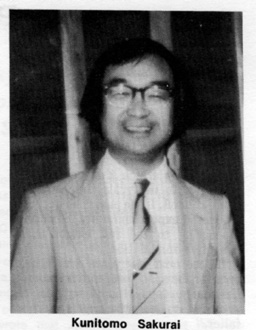 This interview with Dr. Sakurai was obtained by David Swift, Professor of Sociology at the University of Hawaii and Contributing Editor of COSMIC SEARCH. Dr. Swift has had a long standing interest in astronomy and space. A Ph. D. from the University of California at Berkeley, he is author of the books: "Sociology of Education Ideology and Change in the Public Schools," Charles Merrill Publishing Co 1971 and "American Education Sociological View," Houghton-Mifflin 1976. Dr. Swift is currently preparing a new book on SETI, its history and implications.
This interview with Dr. Sakurai was obtained by David Swift, Professor of Sociology at the University of Hawaii and Contributing Editor of COSMIC SEARCH. Dr. Swift has had a long standing interest in astronomy and space. A Ph. D. from the University of California at Berkeley, he is author of the books: "Sociology of Education Ideology and Change in the Public Schools," Charles Merrill Publishing Co 1971 and "American Education Sociological View," Houghton-Mifflin 1976. Dr. Swift is currently preparing a new book on SETI, its history and implications.
Cosmic Search: When did you first think seriously about the possibility that extraterrestrial intelligence might exist?
Sakurai: In the 1950s when I went to the university. Accordingly, I took some courses in biology during my freshman year and planned to major in biology. At that time in Japan there was a very popular book written by Professor Schrödinger, who had developed the idea of quantum mechanics entitled What is Life? Biophysical Processes About Evolution. He never mentioned anything about intelligent life in the universe, but we read it for courses in biology and some other classes. People sometimes talked about the possibility that intelligent life existed elsewhere, and I began to study some of the problems related to it in my freshman year.
C-S: When do you guess that we will actually receive some kind of signal from ETI?
Sakurai: I am still very skeptical about the possibility that some Extra-Terrestrial Intelligence (ETI) is sending us radio signals which contain information about their existence.
C-S: You are skeptical?
Sakurai: Yes. We can send out radio waves to try to find ETI somewhere within 100 light years or so. If we are following some evolutionary trend of the stars and their planets, and most of the civilizations are evolving in the same steps as ours, then maybe some ETI has just reached the stage of civilization that we have. Then they are also trying to send radio waves to communicate with other species. But we are all at the same stage. Therefore it is difficult for me to believe that
maybe 100 years or 200 years ago some extraterrestrial intelligences were already sending us information of their existence.
C-S: You are assuming that any other civilization is progressing at about the same rate that we are?
Sakurai: Yes, within a very close area around the Solar System, because most of the stars within 100 or 200 light years are almost the same age as our Sun. That means that if planetary systems evolved around some stars within that area, they may evolve life at about the same rate as ours. Perhaps beyond our reach some more advanced civilization may exist, but it may be almost impossible to communicate with them.* (* Although a hypothetical civilization on a planet orbiting another sun might be at our identical stage of development, it is not very likely since this would require that their rate of evolution matched ours for billions of years. For the difference to be less than 100 years in a billion years requires matching our average rate to a precision of one-hundred-thousandth of one percent (or one part in 10 million).
Ed.)
C-S: What would be your guess as to when we might actually make contact with them?
Sakurai: Maybe within a couple of hundred years or so we may reach the stage of communicating with each other by sending radio signals, or maybe some other different signals, using gamma rays or neutrinos or laser beams. It may be necessary to develop new techniques.
C-S: Then you do not expect it to happen tomorrow?
Sakurai: No, I don't think so. But we might detect something within a few years because in Japan a 45-meter radio telescope is now under construction, and we may start to search for ETI with it. We are asking for some observing time on the radio telescope. We hope that our project will be accepted. We are very eager to receive some radio waves from outer space. But now we have no possibility of studying ETI by any means.
C-S: There is no one in Japan who is actually studying it?
Sakurai: No one else.
C-S: How may other scientists in Japan are interested in extraterrestrial intelligence? How many would be studying it as seriously as you are?
Sakurai: I guess about thirty people. We have a very small association we call the Association of the CETI. We call it in Japanese "Seti no Kai." "Kai" means small group of association. We have occasional meetings and we discuss the possibilities of existence of ETI and communication with ETI using radio telescopes under construction.
About five people working at the Tokyo Astronomical Observatory are members of the association. Also some biologists, chemists, economists, radio engineers and mechanical engineers are very much interested and they are members of the association, too.
C-S: How important is SETI to you at this time? What priority does it have in your own professional work?
Sakurai: Not too high, because I am doing research on cosmic ray physics, mainly solar-flare particles and solar neutrinos, and some of the problems that may be related to the origin of cosmic rays. But in order to study these problems we have to know what is going on in interstellar space and interplanetary space and on the sun.
Our understanding of the origin of the solar system suggests that the sun was initially produced by action from a supernova explosion. If so, we must study also the sun's origin and the evolution of the planetary system including the earth, which was influenced by the shock wave produced by the supernova.
If we study some very old meteorites, called carbonaceous chondrite, we may obtain information about the birth of our sun and its planets. We may also find very interesting chemical evidence about the original composition of the earth's atmosphere and also the atmosphere of the giant planets and the terrestrial type planets. This knowledge is closely related to the possibility of the origin of life on those planets. Then we have to learn all that happened in the evolution of the planetary system in relation to ordinary life and its evolution. That's why I have become so interested in studying life in the universe. The existence of life in the universe is very closely related to all of the physical and chemical processes of the stars and solar systems. The evolution of life is very important to understand what went on in the history of our universe.
C-S: How about most scientists in Japan; do you think they agree with your view?
Sakurai: I don't think so. We may be considered by most of the scientists in the physics and chemistry community as the unusual guys. Most of those people don't believe in the existence of intelligent life elsewhere in the universe. Some do, but most are very skeptical, especially about the possibility of communication between us and ETI. Some people say to us that this is nonsense but we don't think so.
C-S: Is this true for other scientists as well as the public?
Sakurai: Even some scientists are very skeptical. The public attitude may be different. Now we have some magazines about extraterrestrial life and space travel. These journals are very useful. Many people are very much interested in learning what is going on in the universe, especially on ETI, but their interests are a little different from ours. They don't care very much about the scientific basis. We need to tell them what we are doing exactly on the scientific study of ETI. That's why I am writing along this line.
C-S: Was your intention to inform the general public through the book that you translated and the one that you are writing now?
Sakurai: Yes.
C-S: It was not only just your fellow scientists but also the public, too, that you are trying to instruct?
Sakurai: Yes, I tried to explain to the public what we are doing. The book is for lay persons. I hope my article will be also read by those people. I never use difficult technical words. I just explain the current status of the search for ETI.
C-S: Do you include any mathematics?
Sakurai: No, except for one very simple formula, the Drake equation. Anyone can understand it. It's not very difficult.
 Kunitomo Sakurai is Professor of Physics at Kanagawa University, Yokohama, Japan. Born in 1933 he was educated at Kyoto University. As an undergraduate he majored in physics, particularly cosmic ray physics and geophysics. In graduate school he mainly studied problems related to solar flare particles. After receiving his Ph. D. in 1961 he continued his work at Kyoto University until 1968, first as research associate and later as associate professor.
Kunitomo Sakurai is Professor of Physics at Kanagawa University, Yokohama, Japan. Born in 1933 he was educated at Kyoto University. As an undergraduate he majored in physics, particularly cosmic ray physics and geophysics. In graduate school he mainly studied problems related to solar flare particles. After receiving his Ph. D. in 1961 he continued his work at Kyoto University until 1968, first as research associate and later as associate professor.
From 1968 to 1974 he was senior research associate and then a resident scientist at NASA's Goddard Space Flight Center. From 1975 to 1977 he was professor at the Institute of Fluid Dynamics and Applied Mathematics. Then he assumed his present post in the Institute of Physics at Kanagawa University.
He has published over 100 technical papers in English in professional journals on solar physics and high-energy astrophysics and he has written seven books, one of which, Physics of Solar Cosmic Rays is in English. Several of his publications deal with extraterrestrial intelligence.
|
|
College Courses on "Life in the Universe"
By: Editors
College courses on "Life in the Universe" are becoming increasingly popular. Although dealing mainly
with astronomy, many of the courses include much interdisiplinary material from such diverse areas as biology, medicine, psychology, physiology, semantics and communication.
We would like to include additional institutions. Please send information to Prof. John Kraus, Ohio State University Radio Observatory, 2015 Neil Ave., Columbus, Ohio 43210. Years given, attendance, a syllabus (if available) and other information will be appreciated.
In previous issues we have listed 30 colleges or universities offering or planning to offer courses. We list here another.
Institution: University of Toronto, Dept. of Astronomy
Instructor: Robert F. Garrison
Title: Life on Other Worlds. Full year credit course.
Content: Nucleogenesis, nucleosynthesis, evolution of planetary systems, solar system, spaceship Earth, Mars, beyond Mars, life beyond the solar system, interstellar life, interstellar communication, space colonies.
Textbooks: Asimov "Extraterrestrial Civilizations'; Goldsmith and Owen "The Search for Life in the Universe"
Years given: 8
Enrollment: About 200
|
|
PEOPLE AND PLACES
By: Editors
"Space is an ocean rich with energy, materials and opportunity."
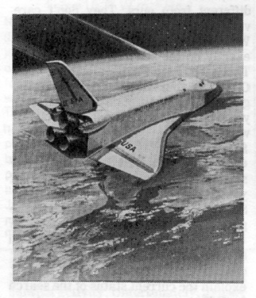 Following Columbia's epic flight, Governor Edmund G. Brown, Jr., of California wrote COSMIC SEARCH as follows:
Following Columbia's epic flight, Governor Edmund G. Brown, Jr., of California wrote COSMIC SEARCH as follows:
"I was proud and excited as I witnessed the spectacular launch and anding of the space Shuttle, Columbia. The frontier which this new vehicle opens up to us rivals the American frontier itself. If the past is an accurate teacher, I expect humanity to continue pioneering to the full extent of its
collective imagination".
"These next few years are crucial ones for the space program and, unlike the early days, many nations are prepared to lead the way should we falter."
"I look forward to working with you to see that the United States asserts its leadership in exploring this new frontier for all humanity."
Sincerely,
Edmund G. Brown Jr.
Governor
In the lead editorial in the New York Times of April 15, 1981, entitled "Space to Grow", Governor Brown commented that America prospers on the new and ingenious and that the space program has given us both. He said that the space shuttle is of profound importance and that there is no way that hunger, pollution and scarcity on the earth will be alleviated without extensive use of our developing technology in space. Governor Brown pointed out that space satellites now monitor forests, crops, soils, waterways, oceans and the atmosphere for their most efficient management and environmental control. Further, he said that locating ore deposits and other valuable earth resources is being accelerated by the broad view from space and that in the future we may be processing asteroids as a major mineral resource. Noting that communication satellites carrying
our telephone conversations and radio and television programs are now common place, he said that the new shuttle-era technology will permit further quantum-jumps in capabilities because the larger and more sophisticated the equipment in space, the smaller the equipment required on the ground and more varied it can be, citing, for example, that home TV antennas for direct satellite reception will be able to shrink from 10 feet to 2 feet to wristwatch scale.
In conclusion Governor Brown said,
"Space, far from its popular image as a useless vacuum, is an ocean rich with energy, materials and opportunity."
"It is fitting that as we grapple with enviromental and economic limits on Earth, we also explore a wider horizon of possibilities in space."
•
Buckminster Fuller, futurist, scientist and inventor of the geodesic dome, celebrated his 86th birthday July 7 at the Franklin Institute in Philadelphia. It was a surprise party attended by many notables. In a little speech at the party Fuller commented that humans, like bees, were introduced into the universe for an important purpose. Bees get honey and perform cross-pollinization. Humans, as part of a grand design, implement the laws of the universe.
In his book "Operating Manual for Spaceship Earth", Fuller once had the following to say about "Piano Tops":
"I am enthusiastic over humanity's extraordinary and sometimes very timely ingenuities. If you are in a shipwreck and all the boats are gone, a piano top that comes along may make a fortuitous life preserver. But this is not to say that the best way to design a life preserver is in the form of a piano top. I think that we are clinging to a great many piano tops in accepting yesterday's fortuitous contrivings as constituting the only means for solving a given problem." (From "Operating
Manual for Spaceship Earth", E. P. Dutton, 1978).
•
SOVIET SETI SYMPUSIUM
V. S. Troitsky and S. O. Kuzmin announce that a symposium on "The Search for Extraterrestrial Intelligence" will be held in Tallin, (Estonia) USSR, December 7 to 12, 1981. Dr. Troitsky is chairman and Dr. Kuzmin is Secretary of the organizing committee. The SETI-81 symposium is jointly sponsored by the Scientific Council on Radio Astronomy of the USSR Academy of Sciences and the Astronomy Society of the Estonian SSR. The SETI-81 symposium will continue a tradition begun in 1964 by the SETI conference held at the Byurakan Observatory in Armenia. The SETI-81 Symposium will be divided into 5 parts:
1. Origin of Life in the Universe.
2. Development of Extraterrestrial Civilizations at the Space-Time Intervals.
3. Modes of the Search.
4. Extrasolar Planetary Systems.
5. Current and Long-range SETI Projects.
It is hoped that about 100 scientists will take part. Anyone interested in participating or attending should communicate with Dr. S.O. Kuzmin, Foreign Secretary, Scientific Council on Radio Astronomy, Karl Marx Prospect 18, 103907 Moscow GSP-3, USSR.
•
A panel of the National Academy of Sciences has advised against building a Satellite Power System to provide electric power on the Earth as too expensive and uncertain to undertake during the next decade. The plan envisioned building huge structures, many kilometers long, in space to collect the sun's energy, then convert this into radio waves and beam them to enormous stations on the Earth where the radio power would finally be converted to 60 hertz and fed into the national power grid. The many conversions necessary to get the power to a user on the Earth reduce the overall efficiency of the system.
Some critics of the Satellite Power System have pointed out that it might be more cost-effective to move those industrial processes that require large amounts of power into space and to collect and utilize the power right there with attendant reduction in the power requirements on the Earth.
•
"Those who can, build. Those who can't, criticize." Robert Moses (1888-1981), New York's master builder of parks, bridges, highways and architect of the future.
•
A Saturn Conference is to be held at TUCSON, ARIZONA, May 11-15, 1982, for the purpose of bringing together the results of recent space missions, earth based observations and theoretical studies. People interested in participating or attending, should contact M. S. Mathews, Lunar Lab, University of Arizona, Tucson, Arizona 85721. (Tel. 602-626-2902).
•
Michael D. Papagiannis of Boston University is the editor of a new book on SETI, which is the proceedings of the SETI cnference of the International Astronomical Union held in Montreal in 1980. Papagiannis was Chairman of the committee which organized the conference and he reported its highlights in COSMIC SEARCH (Winter 1980, Serial No. 5). The proceedings should interest a wide range of people ranging from professional astronomers to educated laymen fascinated by the possibility of finding life outside the Earth. The book should also be valuable to students
taking courses on SETI. Published by D. Reidel Publishing Co. of Dordrecht, London and Boston the book has 276 pages and costs $14.95 in paperbound form.
•
According to an announcement by Carl Sagan, The Planetary Society plans to direct its efforts to assure a full consideration of a space probe to Halley's comet in 1985-86.
A Halley intercept mission is considered to be a once-in-a-lifetime opportunity to examine at close range the most famous comet in history. Halley's comet, a huge ball of ice with dust cloud and tail, returns every 76 years and when it last passed in 1910, brushing the Earth with its tail, millions panicked. Although a U.S. Halley probe had been planned by NASA, cost overruns on the space Shuttle forced NASA to drop the mission. Although the Soviet Union, Western Europe and Japan are all
planning missions to Halley's comet, it would be most unfortunate if the U.S. did not also send a probe since there is much that may be learned from a comet about the processes that produced the sun and the Earth five billion years ago.
Another objective of the Planetary society will be to help support long-term radio searches for extra-terrestrial intelligence.
John Kraus
|
|
Letters:
By: Editors
Letters are always welcome but owing to the volume it is not possible to acknowledge all of them. Also due to space limitations we reserve the right where necessary to condense or edit the contents. Letters may be addressed to: Editorial Dept., COSMIC SEARCH, P.O. Box 293, Delaware, Ohio 43015.
"I have enjoyed that last two issues (10 and 11) even more then usual. The magazine is really making progress!"
Frank M. Wiesenmeyer
Decatur, Illinois
"I, and a couple of others here in Denmark, have started a project which we call "Intelligent Life in the Universe; What does IT look like?" We plan to collect opinions and information from a variety of sources including asking "the man in the street" that question.
Knud Larn
Haslev, Denmark
You should keep in mind that many opinions about extraterrestrials are only conjectures and may not be much more pertinent than asking the man on the street what he thinks the value of Avagadro's number should be. For discussions of the wide variety of living forms which may be possible please refer to the many articles which have appeared in COSMIC SEARCH and in particular the ones on "Generalized Life" by Jerome Rothstein in No. 2, March 1979, and "Not as We Know It", by Isaac Asimov in No. 9, Winter 1981.
-Ed
•
"Your last issue of COSMIC SEARCH (Spring 81) was one of the best yet! Keep up the exciting and worthwhile work. Your publication is fascinating."
George Douglass
Reno, Nevada
|
|
Olber's Paradox, or Why Is the Sky Dark at Night?
By: Robert H. Van Horn
If stars are uniformly distributed there will be 100 times as many (in a given distance increment) at 10 times the distance and collectively they will be as bright as one star at unit distance. Thus, each distance increment contributes equally to the sky background. (Adding up the stars at all distance increments, the total number out to a given distance increases as the cube of the distance.)
Tonight, if the sky is clear, you can go out of doors and make a very significant astronomical observation. You will need no special instruments. Your eyes will suffice. The observation: Note whether the sky is dark or whether it blazes with the light of millions of suns!
It is, of course, a commonplace that the night sky is dark. But that darkness was a puzzle to astronomers and cosmologists from before the time of Newton to the middle of the twentieth century. Newton, and most others during that era conceived of space as three dimensional and infinite. And they thought of time as without beginning or end. Newton's laws of motion and gravity worked as well in calculating the motions of planets, comets, and other bodies. They also worked well in calculating motions of projectiles and machinery. The whole universe was conceived as a giant clockwork whose laws were at last understood...except...
Among the unexplained puzzles were the Milky Way and the nebulosities discovered in various parts of the sky as telescopes got better and better. And the sky was dark at night in spite of the infinity of stars thought to extend throughout what Edmond Halley called "the whole Abyss of Space."
Cosmologists reasoned that the number of stars must indeed be infinite and must extend throughout all space. If not, they would have a center of gravity and over an infinite time they would have gravitated toward one another and all would have coalesced at the center of gravity.
Puzzling over this, Edmond Halley wrote in 1720, "An Argument I have heard urged that if the number of Fixt Stars were more than finite, the whole surface of their apparent Sphere would be luminous for these shining bodies would be more in number that there are Seconds of a Degree in the area of the whole Spherical Surface." Halley recognized that the light from the more distant stars would decrease in proportion to the square of the distance to them. He also recognized that the number of stars at the greater distances would increase in proportion to the squares of their distances. Thus the effects of distance would cancel each other.
Although Halley virtually stated the paradox of the dark sky at night, the full recognition of the paradox is attributed to a German Physician and amateur astronomer, Dr. Wilhelm Olbers. Olbers' paper, "On the Transparancy of the Interstellar Medium," published in the 1826 Astronomical Yearbook, stated, "Should there really be suns in the whole infinite space, they can be at approximately the same distance from one another, and consquently [sic; i.e., "consequently"] the whole sky should be as bright as the sun. Clearly, each line which can conceivably be drawn from our eye will necessarily end on one of the stars and each point on the sky would send us starlight, that is, sunlight."
Olbers concluded that the darkness at night could only be explained if the interstellar medium were not perfectly transparent. He then made some calculations on the opacity of the interstellar medium. Although his calculations are now only a historical curiosity, his name remains attached to the paradox of the dark night time sky.
Today we recognize that the universe and the number of its stars are finite. Moreover, the light from the most distant objects is red shifted, much of it out of the visible range.
So go out tonight and look at the sky. And as you contemplate the darkness you can be aware that you are observing a limited but marvellous universe. There is much more in the darkness than meets the eye.
|
|
The SEnTInel
By: Robert S. Dixon
Does Earth Have Unseen Neighbors?
Our current knowledge of nearby space is such that many unknown objects can and undoubtedly do exist in and near our solar system. They need only be small enough or distant enough to meet two criteria to have escaped detection:
1. Their long-range gravitational effects must be small, or we would detect their effects on the motions of known objects, such as the planets.
2. Their reflected sun light must be dim, or we would detect them directly with optical telescopes.
These criteria are not very stringent, and they allow the existence of a multitude of interesting and unusual unknown objects in our neighborhood.
For example, alien spacecraft and ancient debris from the beginning of the solar system could exist undetected at Lunar distances or greater. Huge planets and even dim starlets could be unobtrusively circling the sun well beyond the orbit of Pluto. Certainly there are myriads of undiscovered small asteroids while our spacecraft continue to discover more planetary satellites, and new comets are found from time to time.
Searching for these unknown objects in our neighborhood is of considerable interest to many astronomers, and recently two unusual searches of this type have been announced. Each is separately described in the sections below:
I - A Search within the Earth-Moon System
There are two points in space within the Earth-Moon system that are referred to as stable equilbrium points. This means that if a small object were placed at one of those points, it would remain there indefinitely. If placed at any other point, the object would not remain stationary and could eventually fall onto the Earth or the Moon, or be thrown out of the system entirely. These two points are called the Lagrangian points L4 and L5, and they are located at the corners of equilateral triangles containing the Earth and Moon. They have been considered as good locations for Earth space colonies (hence the name of the organization "L5 Society"). They may also be good locations to park alien space probes; and they might harbor interesting ancient rocks and debris that could help us understand the origin of the solar system.
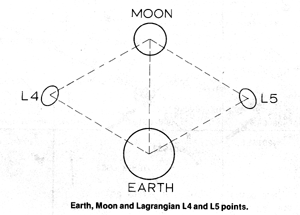 If the Earth and Moon were orbiting each other in isolation from the rest of the universe, the Lagrangian points would really be "points." However, the Sun's gravitational effects cause the "points" to be smeared out into small "ovals" that are approximately centered on the points. Objects will actually be stable only if they orbit around the Lagrangian points at the edges of the ovals. This situation is illustrated in the sketch. All the objects shown lie in the plane of the Moon's orbit around the Earth, and of course the entire system rotates as the Moon revolves around the Earth. As seen from Earth, stable objects in the L4 and L5 ovals would lead or follow the Moon at a nearby constant angle, but would move forward and backward slightly as they revolved around the center of their respective oval.
If the Earth and Moon were orbiting each other in isolation from the rest of the universe, the Lagrangian points would really be "points." However, the Sun's gravitational effects cause the "points" to be smeared out into small "ovals" that are approximately centered on the points. Objects will actually be stable only if they orbit around the Lagrangian points at the edges of the ovals. This situation is illustrated in the sketch. All the objects shown lie in the plane of the Moon's orbit around the Earth, and of course the entire system rotates as the Moon revolves around the Earth. As seen from Earth, stable objects in the L4 and L5 ovals would lead or follow the Moon at a nearby constant angle, but would move forward and backward slightly as they revolved around the center of their respective oval.
A number of searches have been made in these areas of space, using large, earth-based telescopes, high-flying aircraft and Skylab. The most detailed search thus far was made recently by Robert Freitas* (* Dr. Robert Freitas authored the article "The Cereal Box Syndrome" in the Summer 1981 issue of Cosmic Search.) of Santa Clara, California, and Francisco Valdes of the University of California at Berkeley, and their results were published in "Icarus" (volume 42, pp 442-447, 1980). They used the 30-inch telescope at Leuschner Observatory in Lafayette, California, to take 90 photographs which in total cover two 8° by 2° zones, surrounding both the L4 and L5 ovals. They employed a special tracking technique to follow the moving ovals as the photographs were being taken, and introduced an intentional "jog" into the telescope motion-halfway through the exposure to provide a double image of any object that might be discovered. The jog helps to discriminate against
film defects, aircraft lights, and other effects that might cause false alarms.
To the limit of their sensitivity, they found no objects. Their limit is 14th magnitude, or equivalent to a Skylab-sized object. They consider their work thus far as being only preliminary, and recommend future searches with larger telescopes that could push the magnitude limit to 21, thereby enabling detection of objects as small as Pioneer 10.
The search of the Lagrangian points has only just begun. There are many more such points in the Solar System. For example, the Earth-Sun system has two such points, as does every other planet-Sun system. So does every other planet-satellite system (although some of the latter may be severely perturbed by the other satellites).
It would seem inescapable that sometime in the history of the Solar System some objects become trapped at the Lagrangian points. It will be interesting to ultimately find out what they are.
II - A Search Beyond Pluto
Objects whose mass is less than about 1/10 that of the Sun never generate enough heat to ignite their nuclear furnaces and become visible stars. These objects are called brown dwarfs, infrared stars, or low-temperature objects. As they form and contract out of the interstellar medium, they heat up and remain stable sources of infrared (heat) radiation for a long time, but eventually they cool off and solidify. During this contraction period, their apparent temperature depends on their
mass. For example, an Earth-sized object would be about 30°K, a Jupiter-sized object about 100°K and an object on the borderline or becoming a star would be about 2000°K.
There may be several of these objects orbiting the Sun well beyond the orbit of Pluto, or just wandering through nearby interstellar space. They are not visible to normal telescopes because their reflected sunlight is too dim, and because they do not glow from their own light. They could only be detected with the special infrared telescopes that are now coming into operation. There are three infrared surveys of portions of the sky that have been or are now being conducted. These surveys are not necessarily searching specifically for new objects near the solar system, but nevertheless they may detect them along with other sources of infrared radiation. These surveys could and may detect an Earth-sized object at six times Pluto's orbital distance, a Jupiter-sized object at 19 times, and a borderline star at 70,000 times.
In 1982, the Infrared Astronomical Satellite (IRAS) is scheduled to fly, and it will significantly increase our capability to detect these objects. Ray Reynolds and Russell Waller of the NASA-Ames Research Center, and Jill Tarter of the University of California at Berkely recently summarized this entire situation and proposed using IRAS for this purpose. Their report appeared in "Icarus" (volume 44, pp. 772-779,1980). IRAS will be much more sensitive than the previous surveys, for objects ranging from somewhat larger than Earth (a Neptune-sized object could be detected out to 38 times Pluto's distance and a Jupiter-sized object to 400 times) up to those about half as massive as a borderline star (detectable at 11,000 times Pluto's distance). The Space Telescope could, in some size ranges, detect even more distant objects, but it is not suitable for survey-type observations.
The search for these objects has important implications for understanding the structure of the galaxy and the universe. If they are numerous they could collectively constitute a significant fraction of the mass of the universe, and yet have been hitherto invisible. Tarter calculates on the basis of such considerations that only one or two objects within the range of IRAS would be enough to profoundly change our understanding of these subjects.
|
|
A New "Road Map" of the Heavens
A long awaited publication event
By: John Kraus
Astronomers and other watchers of the sky now have an atlas of overlay maps with which to identify one-half million celestial objects. Cuhninating years of work, this atlas has just been published by the Ohio State University Radio Observatory.
Locations and designations are given for the brighter stars, clusters of stars, galaxies, clusters of galaxies, planetary nebulas, absorption nebulas, emission nebulas, blue stellar objects, quasistellar objects, supernovas and many other objects. Celestial and galactic coordinate grids are also included.
The new sky atlas is the most comprehensive ever prepared and will be especially useful because it can be directly compared with the photographs of the National Geographic Society Palomar Sky Survey. The comparison is accomplished by printing the atlas maps on special clear plastic overlay sheets of exactly the same size as the Palomar photographs (14 x 17 inches or 36 x 43 cm). There is one such overlay for each of the 1037 different Palomar fields. The overlays give mankind's present knowledge of the heavens in capsule form with each object referred by number to one of the 300 catalogs on which the atlas is based.
A Palomar sky photograph is like an aerial photograph of the Earth: there are many objects but none are identified. The sky overlays permit the immediate identification of one-half million celestial objects like a geographic map made from an aerial photograph identifies cities, towns, roads, lakes and rivers. The original motivation for preparing the overlays was to assist astronomers in establishing the relationship of radio sources to objects appearing on optical photographs. The overlays will greatly facilitate this work.
The overlays were prepared by Robert Dixon, Mirjana Gearhart, and Paul Schmidtke of the Ohio State University Radio Observatory and were produced and distributed by the Observatory on a non-profit basis. Assistance for the project was provided by the National Science Foundation, the National Geographic Society, the Ohio State University and the Ohio Wesleyan University.
|
The overlays are made of dimensionally-stable abrasion resistant clear plastic. A user may add his own notations on the overlays with water-soluble ink and wipe them off later with a damp cloth.
An important special feature is that the overlays can be used by themselves as detailed sky maps without the Palomar photographs. They may also be used as finding charts by copying any desired portion of the overlays. The overlays are accompanied by a text containing complete reference information for all the objects shown.
|
Caption for Graphic #1 Below
Sample of about one-tenth of overlay map superimposed on Palomar Plate 1357 and reproduced at actual size (in magazine) showing 3 galactic clusters (symbol large G) with prominent edge-on galaxy (indicated by heavy arrow left of center) and broadside galaxy (indicated by heavy arrow right of center). Individual galaxies (symbol LM ), blue objects (symbol: B) and many stars (symbol: 6 digit number) also are shown. At right is summary table accompanying overlay which gives technical information regarding the photograph (coordinates, scales, exposure data, etc.) and the numbers of various kinds of objects appearing on it. The overlay is displaced slightly (to right and above the photograph) to facilitate comparison of overlay positions with photograph objects.
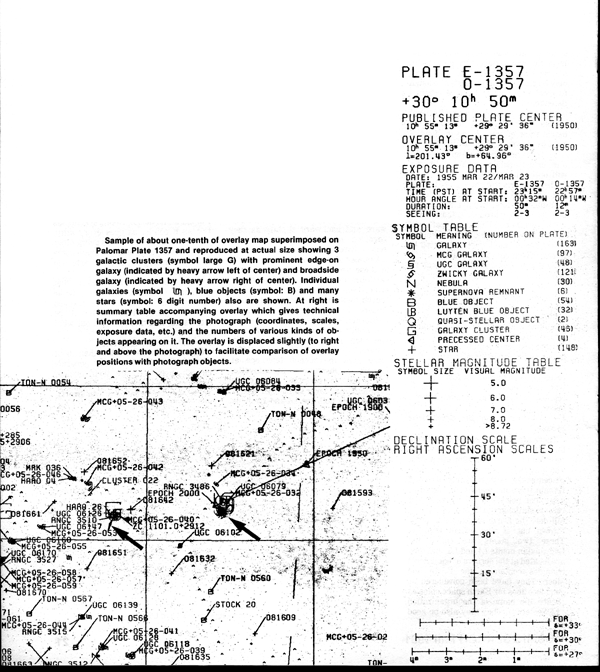
Caption for Graphic #2 Below
Sample of about one-fifth of overlay map superimposed on Palomar Plate 835 and reproduced at actual size (in magazine) showing dense star field with brightest stars identified with 6 digit numbers. Each speck is a star. The overlay is deplaced slightly to right and above the photograph to facilitate comparison of overlay positions with photograph objects and to demonstrate the high precision with which the crosses on the overlay (indicating star positions) correspond to the actual star positions on the photograph. It is a tribute to modern technology that the digital position information of catalogs can be transformed into map positions which agree so well with the actual sky positions.
|
|
ABCs of Space
By: John Kraus
Infra-Red and Ultra-Violet
Isaac Newton demonstrated that a glass prism could separate white light into a rainbow of colors from violet through blue, green and yellow to red. These colors represent different wavelengths of light. Violet wavelengths are shorter while red wavelengths are longer. Newton's rainbow is called a spectrum which, for visible light, extends from a wavelength of 400 nanometers at the violet end to 700 nanometers at the red end. This is the visible spectrum to which the human eye is sensitive. A 2-to-1 difference in wavelength is one octave. The ratio of 700 to 400 is less than 2 to 1 so the visible spectrum is less than one octave wide. By way of comparison, the difference in pitch between the musical notes of middle and high C is one octave, pitch being to sound what color is to light.
Although light is an electromagnetic wave, it may also be referred to as a ray. The term wave calls attention to its wavelike nature while the word ray emphazies the path of propagation which is a straight line in a uniform medium.
Wavelengths shorter than violet (less than 400 nanometers) are called ultra-violet and those longer than red (longer than 700 nanometers) are called infra-red. Bee's eyes are sensitive to ultra-violet wavelengths almost as short as 300 nanometers and some snakes have receptors or pits between their nose and eyes which are sensitive to the infra-red wavelengths.
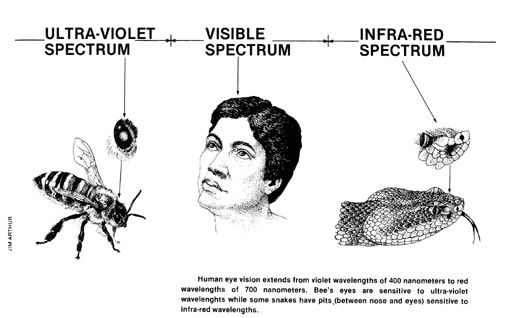
William Herschel, the musician turned astronomer, was the discoverer of infra-red radiation. He had tried glasses of various colors to darken the sun while observing it with his telescopes and found that although red glasses reduced the light effectively they allowed heating of the eye with attendant irritation. He found that dark green glasses or smoked glasses worked much better, reducing both the light and heat. To learn more about the heating and illuminating power of the
sun's rays he contrived an experiment. Using a prism to spread out the sun's light into its spectrum or colors he placed a thermometer successively in the regions of different colors. He noted that the thermometer reading was lowest when in the violet region, higher in the green and even higher in the red. He discovered further that if the thermometer was moved just out of the red end of the spectrum so that it was not illuminated by the sun's light, its temperature went still higher. There were obviously invisible rays carrying the heat, rays which were refracted by the prism and akin to light.
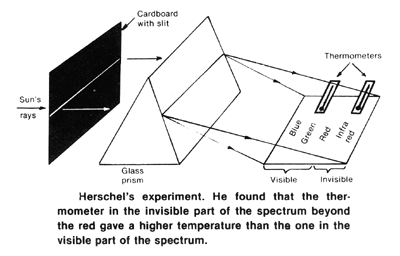 In a series of papers before the Royal Society in London in 1800, Herschel reported on his experiments and called "these invisible rays which produce no illumination but create a sensation of heat, calorific rays or radiant heat." To describe the light rays which produce visible illumination but little heat he used the contrasting term "colorific rays." In further experiments Herschel found that the maximum illumination occured in the yellow-green region in the middle of the "colorific" spectrum (550 nanometers). For calorific and colorific rays we now use the terms infra-red and visible rays.
In a series of papers before the Royal Society in London in 1800, Herschel reported on his experiments and called "these invisible rays which produce no illumination but create a sensation of heat, calorific rays or radiant heat." To describe the light rays which produce visible illumination but little heat he used the contrasting term "colorific rays." In further experiments Herschel found that the maximum illumination occured in the yellow-green region in the middle of the "colorific" spectrum (550 nanometers). For calorific and colorific rays we now use the terms infra-red and visible rays.
A pavement or brick wall baked by a late afternoon sun can, in the darkness of evening, warm one's body from a distance. The heat is conveyed by invisible infra-red rays. Our skin is sensitive to infra-red rays but not to light unaccompanied by heat or infra-red rays. Conversely, our eyes are sensitive to visible light but hardly at all to infra-red rays.
If our eyes were sensitive to infra-red waves instead of light a warm room would appear brighter than a cold one and the inside of a refrigerator would be very dark indeed. A person wearing a white shirt and black pants would appear to have a dark shirt and bright pants. At some infra-red wavelengths (10 micrometers) the sky would appear bright by both day and night while at other wavelengths (2 micrometers) it would appear dark.
In 1801, only a year after Herschel had discovered invisible heat rays beyond the red end of the visible spectrum, John Wilhelm Ritter of Silesia found that invisible rays from the sun beyond the violet induced changes in chemical compounds. Accordingly, these rays were called "chemical" rays. We now use the term "ultra-violet."
Although our eyes are not sensitive to the ultra-violet rays from the sun (between 300 and 400 nanometers), our skin reacts to them by acquiring a tan. It is fortunate that the atmosphere is opaque to ultra-violet rays shorter than about 300 nanometers. If these even more chemically active rays were to penetrate to the earth's surface they would produce biological and ecological effects which could upset the environmental balance. The blocking of rays just short of 300 nanometers is due to absorption by the ozone of the upper atmosphere. The ozone molecules, consisting of three oxygen atoms, are formed from the normal two-atom molecules of oxygen by the ultra-violet rays of the sun.
Mountain climbers at high altitudes quickly acquire a shallow tan from the sun. This results from shorter ultra-violet waves than can reach sea level. The shallow, high-altitude tan doesn't last long. At sea level the tan is due to the longer ultra-violet waves which penetrate the skin more deeply and impart a longer-lasting tan.
Ordinary photographic film responds to ultra-violet while special red sensitive film can be used for infra-red radiation to wavelengths as long as 1000 nanometers. Wavelengths between 300 and 1000 nanometers penetrate the Earth's atmosphere. Throughout this range of wavelengths, called the optical window, ground-based astronomical observations are possible.
Wavelengths longer than 1000 nanometers (1 micrometer) require special thermal detection devices and for wavelengths as long as 1000 micrometers (1 millimeter) the infra-red blends into the short radio wavelengths. Although ground-based astronomical observations can be made through several narrow windows in the 1 to 35 micrometer region, astronomical observations at longer wavelengths to the shortest radio wavelengths are best made from above the atmosphere. Radio waves to lengths of many meters penetrate to the ground through what is called the radio window. However, long radio wavelengths are cut off, not by the atmosphere, but by a charged particle layer above it called the ionosphere.
The ultra-violet spectrum extends to about 10 nanometers where it blends into the long wavelengths of the x-ray part of the spectrum. The Earth's atmosphere is opaque to wavelengths less than 300 nanometers.
Ultra-violet, infra-red, light, x-rays, gamma rays and radio waves are all electromagnetic, extending over more than 50 octaves from gamma rays with wavelengths so short it takes billions of them to stretch across the period at the end of this sentence, to radio waves many kilometers in length. With the advent of telescopes in space above the Earth's atmosphere and ionosphere, this enormous range of wavelengths is now becoming accessible for astronomical observations. In coming "ABCs of Space" I will discuss the "new astronomies" from gamma rays to long radio waves which observations from space are making possible.
This discussion of infra-red and ultra-violet is adapted from a few pages of my new book, "Our Cosmic Universe," Cygnus-Quasar Books, 1980, copyright © John D. Kraus. The Herschel experiment figure and the optical window figure are also from the book.

|
|
Cumulative Index
Vols. 1, 2 and 3
1979-80-81
By: Editors
Vol. 1 (1979, Serial Numbers 1, 2, 3, 4
Vol. 2 (1980), Serial Numbers 5, 6, 7, 8
Vol. 3(1981), Serial Numbers 9, 10, 11, 12
(Last number of listing is page number)
|
ARTICLES
General:
Barnhart, P., ETI in Classroom, 9, 16
Basler, R.P., SETI from Space, 4, 41
Berendzen, R., Cosmic Perspective, 1, 36: 11, 22; The Case for SETI, 2, 25
Billingham, J., NASA and Exploration of Space, 5, 17
Bracewell, R. N., Man's Role in the Galaxy, 2, 48
Cocconi, G., and Morrison, P., Search for Interstellar Communication, 1, 4
Cousins, N., Rendevous with Infinity, 1, 30
David. L, Putting Best Signal Forward, 7, 2
Drake, F. D., SETI, 8, 7; Biological Immortality and SETI, 7, 9; Klingons Became Chimeras, 9, 9; When Brightest is Farthest, 12, 7
Dunwoody, S., Scientific Writing, 8, 8
Freitas, R. A., Cereal Box Syndrome, 11, 16
Kardashev, N., Strategies of SETI: I, 7, 36; II: 8, 4
Kraus, J., We Wait and Wonder, 3, 31
Laurie, J., Science in Mass Media, 7, 39
Michaud, M. A. G., Extraterrestrial Politics, 3, 11
O'Neill, G. K., Space Colonization and SETI 2, 16
Öpik, E. J., Space Travel, Life Beyond Earth, I: 10, 2; II 11, 10
Papagiannis, M. SETI, Joint Session, IAU, 5, 24
Sagan, C., Quest for ETI, 2, 2
Sakurai, K., SETI in Japan, 12, 16
Smith, M. S., Political Realities, 7, 30
Sullivan W., What if We Succeed, 1, 37
Trimble, V., Where Are They, 6, 20
Van Horn, R. H., Knowledge Is Our Destiny, 12, 13
von Puttkamer, J. Where Is Everybody? 13, 43; Are We Alone, 4, 30
von Hoerner, S., SETI, 1, 40
Stine, G. H., Space Industrialization, 6, 26
Tinsley, B. A., Technical Development and Colonization, 8, 10
Wills, D., Martian Safari, 12, 4
Historical Perspectives:
Bell, T. E., Idea of Extraterrestrial Life, 5, 2
Berman, L., What It Was Like before Ozma, 4, 17
Brown, G. H., Marconi, 6, 6
Drake, F. D., A Reminiscence of Project Ozma, 1, 10; On Intelligence: A Wave of the Past and Future, 10, 5
Good, I. J., The Chief Entities, 6, 13
Lago, D., Circles of Stone and Circles of Steel, 2, 10; A Hymn to Life in the Universe, 4, 21
Morrison, P., Twenty Years After, 1, 7
Astronomy and Cosmology:
Bahng, J., Spectral Classification of Stars, 9, 2
Clarke, A. C., Trouble in Aquila, 1, 22
Dodson, W. R., Next Best Thing to Being There, 10, 10
Fowler, W. A., Age of the Universe, 11, 4
Holland, E., What Makes Atoms Tick, 10, 6
Kraus, J., Strange Radiation from Above, 5, 20
Van Horn, R. H., Olber's Paradox, 12, 20
Wheeler, J. A., From Big Bang to Big Crunch, 4, 2
Chemistries of Life:
Asimov, L, Not as We Know It, 9, 5
Lovelock, J. E., Recognition of Alien Biospheres, 8, 2
Rothstein, J., Generalized Life, 2, 35
Rubin, R., Universal Chemical Evolution, 9, 10
Tarter, J., Life in the Universe, 6, 19
Trimble, V., It's a Nice Place To Visit, 5, 13
Cosmic Communication:
Arbib, M. A., Psychology of Interstellar Communication, 3, 21
Cocconi, G., and Morrison, P., Interstellar Communication, 1, 4
Fleury, B. E., Dolphins as Analogs, 6, 2
Freudenthal, H., Towards a Cosmic Language, 5, 35
Kuttner, R. E., Nature of Extraterrestrial Communication, 10, 20
Lago, D., In the Time Machine, 6, 30; Toward a Cosmic Brain, 11, 6
Oliver, B. M., Bio-Cosmology, New NASA Thrust, 3, 16
Pasachoff, J.M., and Kutner, M. L., Neutrinos for Interstellar Communications, 3, 2
Rhodes, W. A., Intra-terrestrial Intelligence, 10, 22
Tarter, J., Communication with ETI, 6, 18
Radio and Radar Astronomy:
Burnell, S. J. B., Little Green Men, White Dwarfs or Pulsars, 1, 16
Jansky, C. M. Jr., My Brother, Karl Jansky, 4, 12
Kraus, J., Diana Waves Back, 7, 27; The First 50 Years: 12, 8
Pankonin, V., Allocationg The Radio Spectrum, 6, 10
FEATURES
ABCs of Space:
Galactic perspective, cosmic perspective, probabilities, wavelengths, 1, 32
Solar system, galaxy, waterholes, unique or average, bandwidth, 2, 39
Star spectra, wavelengths, range, 3, 36
Doppler effect, big bang, mass-size chart, cosmic temperature, cosmic calendar, 4, 25
Gravity waves, solar system signature, 5, 28
Black holes, age of universe, waves, 6, 32
Earth's rings, full spectrum astronomy, redshifts, 7, 16
Universe in 7 steps (steps 2, 3 and 4), 8, 16
Steps, 5, 6 and 7, 9, 20
Spanning space, 10, 14
What is gravity? 11, 18
Infra-red and ultra-violet, 12, 24
College Courses 3, 41; 4, 39; 5, 46; 6, 38; 7, 40; 9, 15; 10, 12; 11, 9
Editorials:
Cosmic Search and SETI, 1, 2
Science and the Multitudes, 1, 3
SETI Through Congress, 2, 15
With the Editors, 3, 10
Stars on Radio, 3, 15
Grand Designs of Past, Present and Future, 4, 11
Technology and Future of Our Civilization, 6, 10
To All Cosmic Searchers, 8, 1
From Editor's Kitchen Table, 9, 1
Planet Earth Spins On, 11, 3
Editor's Statement, 12, 3
E.P.F. Reports: 8, 12; 9, 24; 10, 19; 12, 15
In Review:
American Astronautical Society, Commercial Operations in Space, 11, 13
American Astronautical Society, Shuttle/Space Lab, 11, 13
Asimov, I., Is Anybody Out There? 6, 17
Clarke, A. C., Fountains of Paradise, 7, 43
Cornell, J., First Stargazers, 12, 14
Engdahl, S. L., Planet-Girded Suns, 2, 47
Goldsmith, D., and Owen, T., Search For Life in the Universe, 7, 42
Goldsmith, D., Quest for Extraterrestrial Life, 12, 14
Grey, J., Enterprise, 5, 34
Hoffman, D., Reflections (film), 8, 18
Sagan, C., et. al., Murmers of Earth, 3, 40
Twain, Mark, Capt. Stormfields Visit to Heaven, 10, 17
Wald. G., Why Is the Universe the Way It Is? 2, 47
von Braun, W., and Ordway, F. L, Discoveries from Solar System, 7, 11
Off the Shelf: 1, 46; 2, 52; 3, 42; 4, 47; 5, 48; 6, 12; 7, 35; see 4, 50 and 8, 20 for more detailed listings.
People and Places:
Alcock, George E., 11, 13
Bell, Trudy E., 6, 13
Burbidge, Margaret, 10, 16
Brown, George E, 8, 13
Brown, Governor, 12, 18
Cousins, Norman, 8, 13; 7, 43.
Dixon, Robert S., 10, 19; 12, 22
Frosch, Robert A., 8, 13
Gatewood, George, 8, 13
Gearhart, Miriana, 12, 22
Giacconi, Richard, 11, 13
Glenn, John, 11, 12
Fuller, Buckminster, 12, 18
Hesburgh, Theodore, 8, 13; 10, 18; 11, 12
Kron, Richard, 11, 13
Kuzmin, S. O., 12, 18
Morrison, Phillip, 9, 22
Moses, Robert, 12, 18
Mueller, George E., 9, 22
Oliver, Bernard, 11, 12; 10, 18
O'Neill, Gerard K., 11, 12
Papagiannis, Michael, 12, 18
Penzias and Wilson, 2, 30
Sagan, Carl, 8, 13; 9, 22; 12, 18
Saturn, 12, 18
Schmidtke, Paul, 12, 22
Solar power, 12, 18
Sonneborn, George, 10, 19
Sullivan, Walter, 7, 43
Thompson, Dietrich, 11, 13
Troitsky, V. S., 12, 18
Wilford, John N., 8, 13
Roadmap of Heavens: 12, 22
SEnTlnel:
Planets. Shklovsky, funding, frequencies, Bracewell, hologrpahy, solar power, 1, 25
Frequencies, Penzias and Wilson, range, bandwidths, 2, 30
Planets, Mars, Chemotons, computers, SETI hearings. 3, 26
Gravity waves, pulsed signals, ultra-c, great galactic rings, viruses, planets, 4, 36
NASA-Ames SETI Conference report, on-the-air SETI programs, 5, 40
Flag of Earth, Jovian moon, finger prints, gravity waves, STARTAPES, quantum theory, 6, 44
Gravitational lens, black holes, Metalaw, chain of life bibliography, occulations, Earth life, 7, 44
Dinosaurs, ultra-c, black hole, 8, 14
Project Oasis, SETI song, 9, 19
Garbage dumps, 10, 13
People or machines, Russian SETI, 11, 8
Unseen Neighbors, 12, 21
|
|
Miscellaneous Items
Webpage Table of Contents (Bookmarks)
(Internal links to categories of items in this webpage)
Information About the Publication
(Editorial Board, Editors, Table of Contents)

COSMIC SEARCH - an international, interplanetary, interstellar, intergalactic magazine
Editors, and Others Involved in the Publication
Editor: John Kraus, Director, Ohio State University Radio Observatory
Contributing Editors:
Robert S. Dixon, Ohio State University
Frank D. Drake, Cornell University
David Swift, University of Hawaii
Robert H. VanHorn, Bell Telephone Laboratories (retired)
Assistants: Alice Kraus, Pene Curmode, Hazel Snyder, Jane Reed
Staff Artist: Jim Arthur
Editorial Board
- Richard Berendzen, President, The American University
- John Billingham, Director SETI Program, NASA-AMES Research Center
- Ronald Bracewell, Director, Radio Astronomy Observatory, Stanford University
- Arthur C. Clarke, Sri Lanka, author of "2001, A Space Odyssey"
- Norman Cousins, Chairman, Editorial Board, SATURDAY REVIEW
- Frank D. Drake, Director, National Astronomy and Ionosphere Center (Arecibo), Cornell University
- Donald S. Hall, Director, Strasenburgh Planetarium, Rochester, New York; Past President, International Planetarium Society
- Theodore M. Hesburgh, President, University of Notre Dame
- Nikolai Kardashev, Space Research Institute, Academy of Sciences, Moscow, USSR
- Philip Morrison, Physics Department, Massachusetts Institute of Technology
- Bernard Oliver, Vice President, Hewlett-Packard Company; Director of NASA-Ames Cyclops Project
- Cyril Ponnamperuma, Director, Laboratory of Chemical Evolution, University of Maryland
- Martin Rees, Director, Institute of Astronomy, Cambridge University, England
- Carl Sagan, Director, Laboratory for Planetary Studies, Cornell University
- Walter Sullivan, Science Editor, New York Times
- Vasevolod R. Troitsky, Radiophysical Scientific Research Institute, Gorky, USSR
- Sebastian von Hoerner, National Radio Astronomy Observatory
About COSMIC SEARCH
The name COSMIC SEARCH is a registered trademark.
COSMIC SEARCH is published quarterly (Winter, Spring, Summer, Fall) by Cosmic-Quest, Inc. Copyright © 1981 by Cosmic-Quest, Inc. All rights reserved. Cosmic Quest, Inc., is a non-profit educational-scientific organization.
Opinions expressed by persons writing in COSMIC SEARCH are their own and do not necessarily reflect the opinions of the editorial staff.
Subscription price: $10 for 4 issues in U.S. (and possessions), $13 elsewhere. Single copies: $2.50 in U.S. (and possessions), $3 elsewhere.
Address subscriptions and all other correspondence to: Radio Observatory, Box 293, Delaware, Ohio 43015.
Second-class postage is paid at Delaware, Ohio, and at additional mailing offices.
Note to subscribers: The last digits of the top line of your address label indicate the last issue of your subscription.
Front Cover
Karl Jansky, his antenna and our galaxy. Story on page 8.
Table of Contents (in magazine)
| Contents | Pg |
|---|
| "Martian Safari" by Dorothy Wills | 4 |
|---|
| "When the Brightest Is the Farthest" by Frank D. Drake | 7 |
|---|
| "The First 5-Years of Radio Astronomy, Part 1: Karl Jansky and His Discovery of
Radio Waves from Our Galaxy" by John Kraus | 8 |
|---|
| "Knowledge Is Our Destiny" by Robert H. Van Horn | 13 |
|---|
| "Extrasolar Planetary Foundation Report" by George Gatewood | 15 |
|---|
| "SETI in Japan - An Interview with Kunitomo Sakurai" by David Swift | 16 |
|---|
| "Olber's Paradox" by Robert H. Van Horn | 20 |
|---|
| Features: | |
|---|
| Donors | 2 |
|---|
| Editor's Statement | 3 |
|---|
| In Review | 14 |
|---|
| College Courses | 17 |
|---|
| People and Places | 18 |
|---|
| Letters | 19 |
|---|
| SEnTInel: "Unseen Neighbors" | 21 |
|---|
| New "Roadmap" of the Heavens | 22 |
|---|
| ABCs of Space: "I-R and U-V" | 24 |
|---|
| Cumulative Index (1979-80-81) | 27 |
|---|
Editor's Statement
With this issue COSMIC SEARCH rounds out its first three years of publication.
My original motivation in proposing COSMIC SEARCH was to generate funds to help finance scientific research at a time of dwindling state and federal support. In particular I wanted to help Robert Dixon's long-term on-going project with the big
Ohio State University radio telescope looking for intelligent signals from beyond the Earth, a search that has logged more
on-the-air time than any other in the western world. For years I had donated personal funds through the Ohio State University
to aid this research. Naively, I thought that a magazine might help. So a number of us formed Cosmic Quest, Inc., a non-
profit, scientific-educational organization, to publish COSMIC SEARCH with any income over expenses available to assist
not only Dixon's work but also deserving research at other institutions as, for example, George Gatewood's at the
University of Pittsburgh. But it didn't work out that way; the magazine lost $50,000 in its first two years and to continue has required a reduction in the number of pages and relying on an almost completely volunteer staff. Even so, we are still running at a loss and would not be able to keep going were it not for many generous donations.
Originally I had hoped that Bob Dixon would become editor but he did not have time so with the very first issue I assumed
responsibility for editing as well as publishing and distributing the magazine, doing this as a completely voluntary effort
sandwiched into an already very busy schedule.
The volunteer assistance of many people has been vital. Currently, James Arthur, Frank Drake and Robert Van Horn are
helping greatly and I am counting on their continued assistance. In particular, I thank my wife, Alice, for her help without which publication would have ceased long ago.
John Kraus
THANK YOU!
COSMIC SEARCH expresses sincere thanks to the following donors who are helping to make sure that the story of SETI and mankind's future continue to be told in an interesting and factual way.
Planetary Donors
Robert J. Allen, Blythdale, Missouri
George Austin, M.D., Loma Linda, Cal.
Donald R. Blaney, Seattle, Washington
Jane L. Brooks, Adelaide, S. Australia
Vera Buescher, Mountain View, Cal.
Jack Craig, Oregon City, Oregon
William E. Dorion, McLean, Virginia
Amahl S. Drake, Ithaca, New York
Harry Duke, Los Altos, Cal.
Harold Early, Ann Arbor, Mich.
Nancy F. Eberbach, Ann Arbor, Mich.
Hale P. Faris, San Jose, Cal.
B. Fredricksen, White Bear Lake, Minn.
Richard and Maria Gauthier, North Bay, Ontario
Paul J. Hurn, Seven Mile, Ohio
James C. Killman, Sherman, Texas
David M. Laida, Sierra Vista, Arizona
Nelson Lecklikner, Novata, Cal.
John L. Mohn, San Antonio, Texas
Arthur J. Morgan, New York, N. Y.
William Rhodes, Phoenix, Arizona
A. V. Shaver, Winchester, Virginia
Paul Simmons, Sheboygan, Wis.
Eric W. Six, Iowa City, Iowa
Rohert S. Strause, Stroudsburg, Penna.
John B. Theiss, Tucson, Arizona
Inge Bjart Torkildsen, Montiquar, France
Dennis Wildfogel, Pomona, N.J.
One Anonymous
Stellar Donors
Jane L. Brooks, Adelaide, S. Australia
Keith Conrad, Toledo, Ohio
George L. Douglass, II, Reno, Nev.
Harold Early, Ann Arbor, Mich.
John Fadum, Boca Raton, Florida
David C. Halley, Colonial Hts., Vir.
Christopher E. Mullin, Sr., Tiburon, Calif.
Virginia Shaver, Winchester, Vir.
Paul Simmons, Sheboygan, Wis.
John Teetor, Marion, Ohio
C.L. Turnage, Camarillo, California
Cosmic Donors
Two anonymous
COSMIC SEARCH, published by a non-profit scientific-educational organization, has been granted tax-exempt status by the Internal Revenue Service, so contributions are tax-deductible (but subscriptions are not). On a combination donation-subscription or donation-renewal, the amount over and above the magazine cost is tax deductible. For example, if a donor sends $30 (qualifying as a "Planetary Donor") and includes a two-year subscription at $18, the $12 difference is tax-deductible.
Donation categories are as follows:
Planetary: $30 per year
Stellar: $100 per year
Galactic: $500 per year
Cosmic: $1000 per year
Contributions, however, will be gratefully accepted in any amount. Checks should be made payable to Cosmic Quest, Inc., P.O. Box 293, Delaware, Ohio 43015.
Help COSMIC SEARCH
Be a Friend of the Cosmic Quest
COSMIC SEARCH AWARDS
For best papers on SETI
Category 1. Undergraduate students
Category 2. Graduate students
Category 3. Anyone else under 30 years of age
Papers may be on any aspect of the Search for Extra-Terrestrial Intelligence (SETI). Papers must be double-spaced typewritten with one inch margins on 81/z by 11 inch bond paper and less than 2000 words in length. Any illustrations must be clearly executed.
Authors of best papers will be given a COSMIC SEARCH AWARD of $100 and the paper will be published in COSMIC SEARCH. Authors should include their full address and telephone number. Authors should enclose a self-addressed stamped envelope if they wish to have their manuscripts returned.
Manuscripts may be submitted at any time. Their review is a continuous, on-going process. Each article received is reviewed by a special committee and if judged worthy, either in its original form or after revisions, will be given a COSMIC SEARCH AWARD. The opinion of the committee is final.
A contestant may submit and have under review only one manuscript at a time and be eligible for only one COSMIC SEARCH AWARD in one category. However, it is possible for one person to achieve COSMIC SEARCH AWARDS sequentially in each
of the three categories.
Address COSMIC SEARCH AWARD Committee, Radio Observatory, P.O. Box 293, Delaware, Ohio
43015.
|
Previous COSMIC SEARCH Award Winners are:
"Circles of Stone and Circles of Steel" by Don Lago (Serial no. 2).
"Aliens in Our Oceans: Dolphins as Analogs" by Bruce E. Fleury (Serial no. 6).
"The Next Best Thing to Being There" by William R. Dodson (Serial no. 10).
|
Miscellaneous Quotes
The following quotes are not directly associated with any article.
The following three quotes were located on page 13.
"Scientists are the true driving force of civilization."
James Burke in "Connections"
"Our passion for learning is our tool for survival."
CarlSagan
He who knows not and knows not that he knows not is foolish.
But he who knows not and knows he knows not is wise.
Anon
|
![[NAAPO Logo]](../../Images/NAAPOsm.jpg)







